




















April
e ditor and Publisher: luis@gotrum.com
e xecutive e ditor: margaret@gotrum.com
Cigar and r um: philip@gotrum.com
Angel’s s hare: paul@gotrum.com
r um h istorian: marco@gotrum.com
r um in the n ews: mike@gotrum.com
Cooking with r um: sue@gotrum.com
w ebmaster: web@gotrum.com
d irector of Photography: art@gotrum.com
i f you would like to submit news or press releases, please forward them to:

news@gotrum.com

You can download the free electronic version (low-res) of this magazine, or purchase the high resolution printed version at:
WWW. got R um . com
The printed version of “ g ot r um?” is produced with F s C-certified paper, which means it is from responsibly managed forests and verified recycled sources.


i t took a lot of imagination and tinkering by the original designers and builders to come up with all the elements and processes of the first sugarcane mill. From crushers and presses to boilers and evaporators, the modern mills are giant assembly lines comprised of multidisciplinary apparatuses that appear to work together seamlessly.
i n s panish-speaking countries, they are known as Ingenios Azucareros , a tribute to the ingenuity of their initial designers (and often of their operators as well).
w e covered the evolution of the mills in last year’s series “ t he s ugar m ill: o rigins and e volution ” and i have also shared news with our readers about the alarming pace at which sugarcane mills around the world are shutting down.
At a recent m oonshine u niversity class, i mentioned the closing of the mills to some of the students, and they asked what i thought had to happen in order to slow down or to stop the attrition rate. m y answer was simple: we need people to approach the subject with an open, clear mind, so that we may truly innovate. i n this month’s h awaiian Rum t ravels Part 2 , m ike Kunetka shares his visit to Kō Hana Distillers and some of the innovative things that they are doing, such as, crushing the cane on the field (rather than at the mill) and pitching the yeast immediately after crushing. These are examples of creative/innovative approaches, and the sugarcane world needs to have more of them.
s teve Jobs famously said that “ no one wants to die. Even people who want to

go to heaven don’t want to die to get there. And yet death is the destination we all share. No one has ever escaped it. And that is as it should be, because Death is very likely the single best invention of Life. It is Life’s change agent. It clears out the old to make way for the new .”
h opefully our generation will be able to see new technologies and approaches in the sugarcane milling industry, which will allow for the survival of the active mills and, hopefully, the re-birth of old ones.
Cheers!
l uis Ayala, Editor and Publisherdo you want to learn more about rum but don’t want to wait until the next issue of “got rum?”? Then join the “rum lovers unite!” group on linkedin for updates, previews, Q&A and exclusive material.
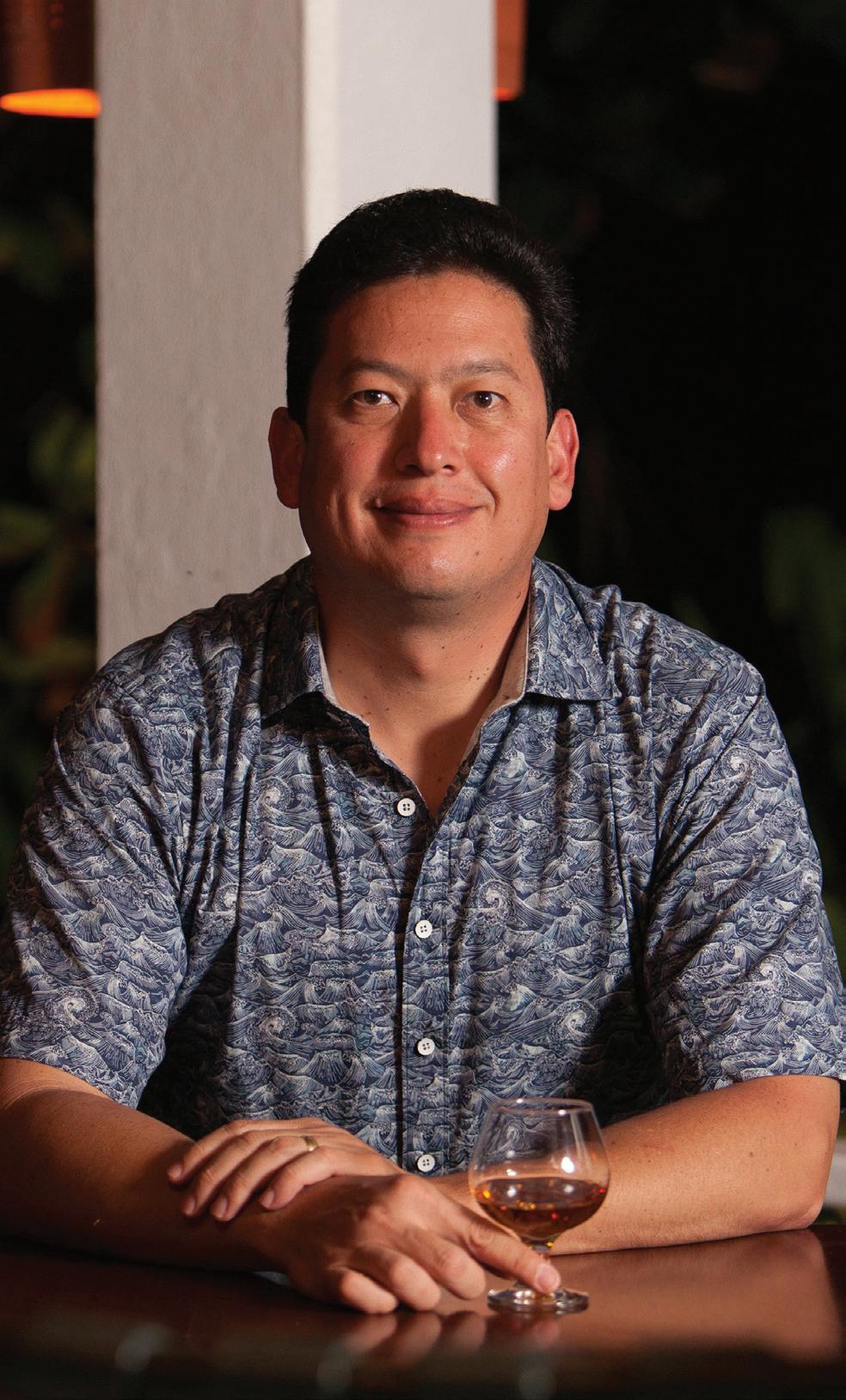
m y name is Paul s enft - r um r eviewer, Tasting host, Judge and w riter. m y exploration of r ums began by learning to craft Tiki cocktails for friends. i quickly learned that not all rums are created equally and that the uniqueness of the spirit can be as varied as the locales they are from. This inspired me to travel with my wife around the Caribbean, Central America, and u nited s tates visiting distilleries and learning about how each one creates their rums. i have also had the pleasure of learning from bartenders, brand ambassadors, and other enthusiasts from around the world; each one providing their own unique point of view, adding another chapter to the modern story of rum.

The desire to share this information led me to create www.RumJourney.com where i share my experiences and reviews in the hopes that i would inspire others in their own explorations. i t is my wish in the pages of “ g ot r um?” to be your host and provide you with my impressions of rums available in the world market. h opefully my tasting notes will inspire you to try the rums and make your own opinions. The world is full of good rums and the journey is always best experienced with others.
Cheers!
Bacoo rum is a product of the d ominican r epublic that is produced by s ans w ine and s pirits, based in i rvine, California. w hile the exact distillery it is produced at is not disclosed, the company does share that the sugarcane used to make the rum is grown in the Central d ominican r epublic. The company makes the rum by pressing the cane and fermenting the fresh pressed juice. After distillation, the rum is aged in used oak barrels and blended to 40% AB v before being bottled and boxed on the island for distribution. The company claims that it does not use any additives and that the age stated is the true age of the spirit.
The custom designed 750 ml bottle with gold and white labels provides the basic information about the rum. A white neck hanger connected to the bottle provides additional information about the product. The wood cap is secured to the bottle with a clear neck wrap as well as a security strip. The cap holds a synthetic cork.
The liquid in the bottle and glass has a dark copper color. s wirling the rum created a medium band that thickens slightly before dropping a single wave of fast moving legs. The band continues to thicken and evaporates quickly, leaving a ring of residue and beads in its wake.


The aroma delivers notes of sweet vanilla with a balance of light nuttiness, brown sugar, baking spices, and warm fig jam.

The first sip of the rum leads with a dark toffee flavor with an undertone of bitter cooking chocolate. This bitterness transitions slowly from the cooking chocolate to baking spices and charred oak tannins, which together create the foundation of the flavor profile. As the toffee notes fade, the dark sugar berry fig flavor quickly forms, then fades as the oak notes take over with a light peppercorn note that finally leads to a long, lightly toasted, astringent finish.
The name Bacoo is based on Caribbean and g uyana folklore that involves mischievous ghosts reminiscent of bogarts and poltergeists found in bottles. i am happy to report that while the marketing of the brand is memorable, sipping it will not lead you to fending off ghosts. o verall, i found the rum to be a balanced sipping spirit. The sweet flavors and the earthy oak and spice notes combine to create a unique experience. i particularly like the dark sugar berry fig note, as it is not something i have encountered often in rum flavor profiles. i f you enjoy rums produced in the d ominican r epublic, this one is worth taking some time exploring.

The first time i heard of Kraken g old s piced r um was with the words, “ d eep in the Kraken’s Keep lies its greatest treasure yet—gold.” n ew for 2023 from Proximo s pirits is Kraken g old s piced r um, a lighter spiced rum blend than the other products the brand has released over the years. The rum is produced in the d ominican r epublic and blended to 35% AB v, which out of the gate is a huge departure from the 47% AB v core product that is from Trinidad and Tobago. The company is clear that the rum is blended with spices, other natural flavors, and caramel coloring.
The 750 ml bottle is the same custom design as the original product, with its double finger rings and embossed glass. The labels have a metallic rose copper background with black, copper, and white designs and lettering front and back.
i n the bottle and glass, the rum holds a solid caramel color. s wirling the liquid creates a medium band that quickly thickens and drops a series of fast moving legs. The last round of legs slow down and creep down the side of the glass as the band evaporates, leaving behind a ring of residue.
The aroma starts with a robust caramel note, that is followed by notes of cooked bananas, baking spices, cola, cinnamon, and toasted oak, with vanilla rounding it out.

The first sip was a little surprising, as it hit differently than the aroma. They
g ot Rum? April 2023 - 8
have a bit more oak tannin in play than i expected or had encountered with other Kraken products. v anilla and spice notes intermingle with notes of caramelized banana, nutmeg, and allspice. As the rum begins to fade, a light mineral and tannic astringency mingles with the sweet caramel notes in a short finish.
o ver the past decade, i have evaluated quite a few spiced rums, from under proofed stale blends, to cinnamon bombs, anise driven nightmares, to well-crafted spirits that showcase the creativity and skills of the blenders. Could the Kraken defeat the Captain? Kraken g old s piced r um is surprisingly balanced, and if it gets traction, it could compete with other spice rums that have dominated the market for quite some time.
w hen evaluating spiced rums, i always make a rum and coke, and the cola neutralized any astringency and rough spice notes in the profile, turning it into an easy to drink highball with all the flavor nuances that never let you forget it is a Kraken rum product. h owever, the versatility of the spirit goes beyond that of sodas like Coca-Cola, and it is flavorful enough to add a spicy twist to some old favorites like a d aiquiri, m ojito, or wherever your curiosity and creativity take you. m oderately priced and entering the market now, if you are up for trying a new spiced rum, i think this one will serve you well.
T he A ngel’ s sh A re
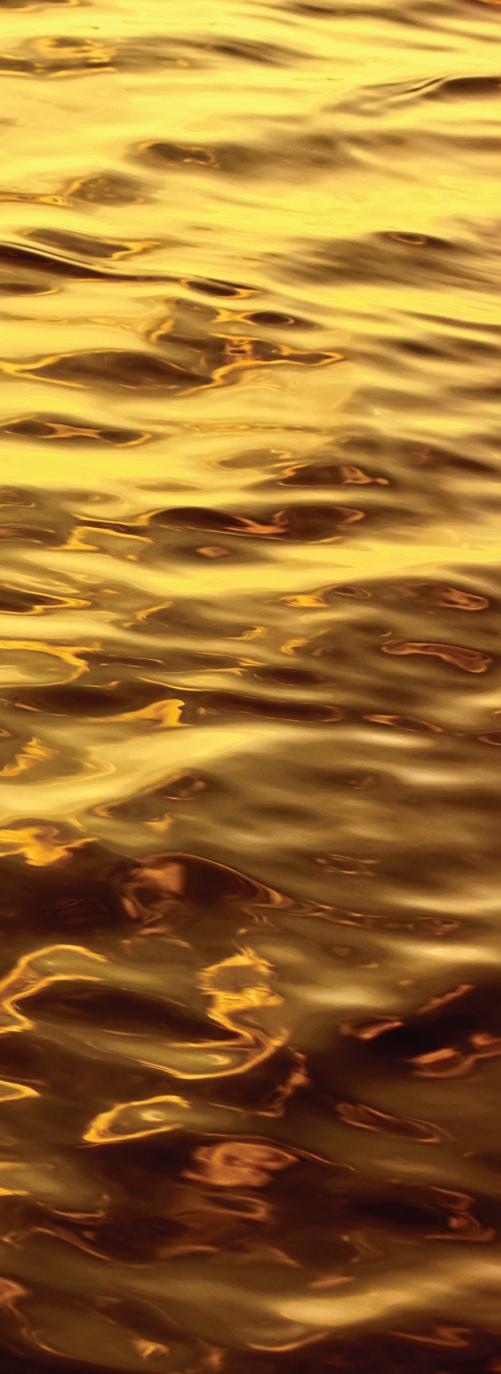


 by Chef Susan Whitley
by Chef Susan Whitley

i ngredients for the s alad:
• s pring m ix
• 1 m ango, peeled, pitted and cut into wedges
• 1/4 C. r ed onions, chopped
• 1/4 C. r ed Apples, diced

• 1/4 C. d ried Cranberries
• 1/4 C. Candied Pecans (or w alnuts)
• 1/2 C. Freshly g rated Parmesan Cheese
i ngredients for the v inaigrette d ressing:




• 1 C. Fresh m ango, cut into one inch pieces
• 1/2 l emon, juiced
• 2 Tangerines, juiced
• 1 o range, juiced
• 1 Tbsp. Balsamic v inegar
• 2 Tbsp. d ark r um
• 1 1/2 Tbsp. m aple s yrup
• 1 Tbsp. Coconut o il
• s ea s alt, to taste
i nstructions for dressing:
1. Juice lemon, tangerines and orange into a small bowl. s lice mango into oneinch pieces. Put all ingredients in a food processor and blend until smooth.
2. i n a large bowl add s pring m ix, red onions, red apples, cranberries, candied pecans and parmesan cheese. Pour the dressing over the salad and toss together.

i ngredients:

• 4 r ipe Peaches (halved & pitted)
• 3 tbsp m aple s yrup
• 2 Tbsp. d ark r um




• 1/2 tsp. Cinnamon
• 1/2 tsp. s ugar
• v anilla i ce Cream
d irections:
1. Preheat grill to 400°F.
2. Place peaches, cut side down, on grill.
3. Close grill lid and cook for 5 minutes. i n a bowl, mix maple syrup with rum. Flip peaches and brush with maple syrup and rum mixture. s prinkle cinnamon and sugar over peach tops. Close lid and continue cooking for 1 minute.
4. r emove from grill. Place peaches in a bowl with vanilla ice cream and serve immediately.
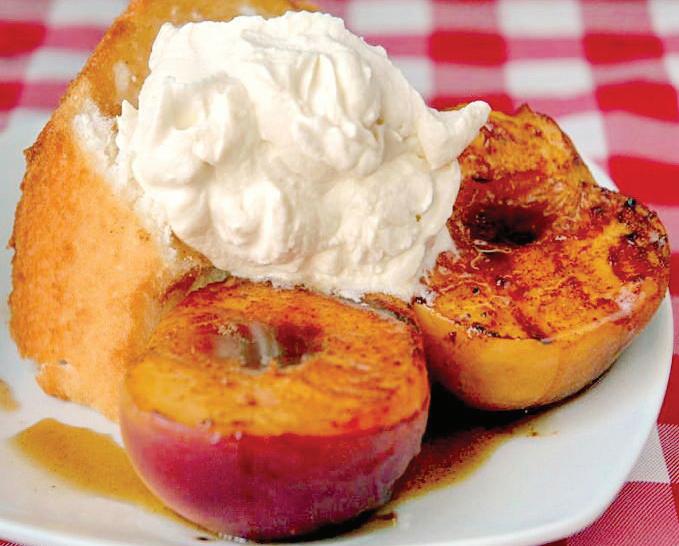



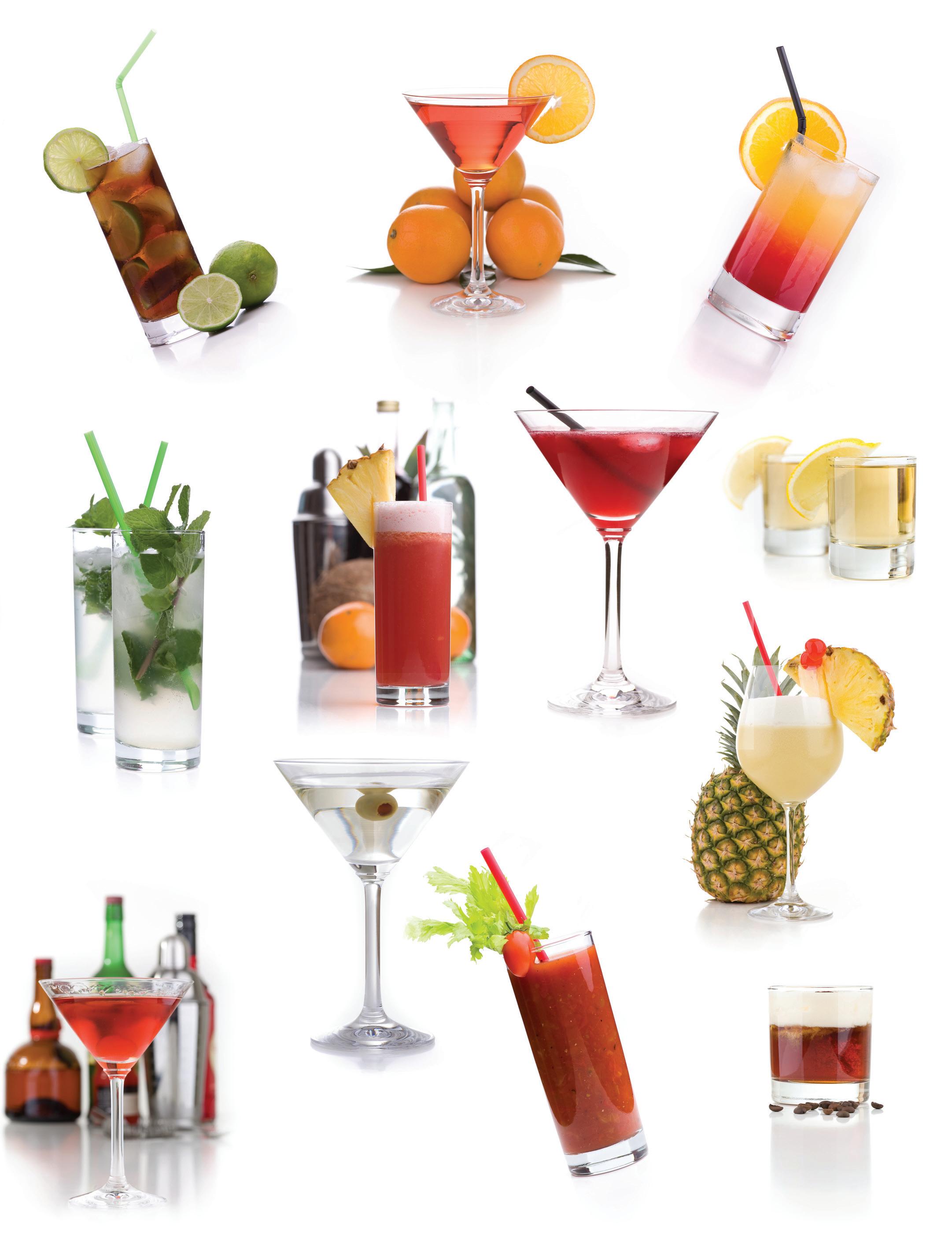

Are you looking for festive reasons to raise your glass this month?

h ere are a few of them!
w rite to us at info@gotrum.com if we missed any!
APR 6 n ew Beer’s e ve
APR 7 n ational Beer Day
APR 9 n ational g in & tonic Day ( us )

APR 17 m albec World Day
APR 19 n ational Amaretto Day
g ot Rum? April 2023 - 18

Then pour more rum, the bottle stopping, Stir it again and say it’s topping.”
- o ld n ew e ngland r hyme
( s ource: The e ncyclopedia of r um d rinks)
Featured Cocktail: h ot Ale Flip
According to Corin h irsch, author of Forgotten Drinks of Colonial New England , the h ot Ale Flip (or just “Flip”) was very popular across the colonies in the 1700s. i t was served far and wide, from highsociety locales like n ew York City’s famed Fraunces Tavern (patronized by g eorge w ashington himself) to the lowly dives of Boston, where Flip-fueled bar brawls led to “murder-by-fire-poker” in at least one instance!
i ngredients:
• 3 oz. (6 tablespoons) d ark r um, preferably n ew e ngland s tyle
• 2 Tbsp. m olasses or m aple s yrup
• 2 l arge e ggs, Beaten
• 1 Pint (16 fluid ounces, or 2 cups) dark beer such as brown ale, porter, or stout

• o ptional: g arnish with freshly grated nutmeg
d irections:
1. Add all ingredients to a large mug
2. Combine ingredients well
3. o ptional: h eat a fire poker in coals until red-hot. Pull it out of the fire and plunge it into the mug. r emove it when the bubbling stops.
(For n ational Beer d ay) g ot Rum? April 2023 - 19
“Landlord, to thy bar room skip, Make it a foaming mug of flip. Make it of our country’s staple: Rum, New England sugar maple.

m y name is Cris d ehlavi and i am a native of Arizona, but have lived in Columbus, o hio since 2002. i just took on an exciting new role as the Brand e ducator for Columbus for d iageo brands. i ran the bar program at “ m ”, of the Cameron m itchell r estaurant group from 2002-2020. i am currently the v ice President of Columbus us B g and was one of the founding members of the chapter.


i n 2013, i attended the rigorous B.A. r . 5 d ay s pirits Certification and have been recognized as one of the top mixologists in the u s .A. i am one of the senior managers of the prestigious apprentice program at Tales of the Cocktail and work as a mentor to many bartenders around o hio.
m y contribution to g ot r um? magazine will include everything from reviews of national cocktail events, articles on mixology, garnish trends, recipes and techniques, to interviews with some of the leading bartenders in the industry.

g ot Rum? April 2023 - 20
s pring is in the air, and you can find a m ojito, or a variation of such, on just about every spring/summer cocktail menu in the us A. s trawberry, watermelon, blueberry, and peach are some of the more common flavors people tend to highlight. As far as historians can tell, the origin of the m ojitio dates back to 16th-century Cuba. i t is a traditional Cuban highball and one of the most popular drinks across the Americas. o ne of the origin theories goes back to 1586 when r ichard d rake sailed to h avana after his raid on Cartagena de i ndias and dealt with a scurvy and dysentery epidemic on the ship. The native i ndians of s outh America had ingredients for “medicinal remedies,” including aguardiente (crude high-proof “fire water”), mint, sugarcane, and lime juice. o ther history experts believe that African slaves who worked in the sugar cane fields in Cuba may have concocted something similar, as it was sweet and very refreshing to enjoy in the heat of the summer. The name Mojito also has fascinating origins…. mo J o is a Cuban spice made from limes-- and mo J o is also an African word that means “to cast as the spell.”
The ingredients are quite simple: rum, mint, lime, sugar, and a splash of sparkling water. Those proportions vary regionally. s ome bartenders muddle the mint, and some simply shake the drink with the mint in the shaker. m any people believe that the mint should be strained out of the actual drink with just a fresh sprig on top, and just as many people insist that the mint should all stay inside. i don’t know if there is a correct or incorrect way, as long as the result is a balanced and delicious drink. i like to strain the mint out so that the person drinking it does not end up with pieces of mint in their teeth! A creative way to

g ot Rum? April 2023 - 22

switch up the classic recipe is to add seasonal fruits, and i have included a few recipes below. i always follow the standard recipe and adjust the lime and sugar slightly based on the sweetness/ tartness of the fruit you are using. Another way to change up a m ojito is to switch out the mint for another herb. A m ojito made with basil is one of the most refreshing and aromatic drinks i have ever had. n ow let’s talk about the best part: what type of rum should you use? The earliest m ojito was written as using unaged Cuban rum. i don’t necessarily think it h A s to be Cuban because you can have some fun, funky flavors from other styles of rum too. i believe it should be an unaged rum, which will lend to a lighter, crisper cocktail that showcases fresh herbs. h ere are a few of my twists on this beautiful classic cocktail.
1.5 oz. u naged Cuban r um
.5 oz. s mith and Cross r um
.5 oz. s imple s yrup (adjust this according to the sweetness of the pineapple)

1 oz. Fresh l ime Juice
8-10 m int l eaves
4-5 Chunks of Fresh Pineapple
i n the bottom of the mixing glass, muddle mint leaves, pineapple chunks, and simple syrup. Add rum, lime juice, and ice. s hake well, then double strain into a tall glass. Add ice, three pineapple chunks, and a fresh mint sprig. Top with a splash of club soda.
2 oz. u naged Jamaican r um
.5 oz. s imple s yrup
1 oz. Fresh l ime Juice
3 Basil l eaves
m uddle basil leaves and simple syrup in the bottom of the mixing tin. Add rum, lime juice, and ice. s hake well, then double strain into a tall glass. Top with a splash of club soda and a basil leaf.
Pro tip: Fresh berries work great in this cocktail, too, just add them to your tin, and don’t forget to garnish with fresh ones.
r eviews of books related to sugarcane, milling, fermentation, distillation, aging, blending and other topics related to the production or history of rum.

www. r um u niversity.com
g ot Rum? April 2023 - 24

(Publisher’s
r eview)s ugarcane is the most important plant source for sugar and alcohol production and is cultivated in more than 80 countries in tropical and subtropical areas. h owever, environmental factors negatively influence its yield and jeopardize the prospect to meet the increasing demand for sugar, other sugarcane derived by products and bioethanol. The development of stress tolerant plants is fundamental for the maintenance and increase of crop yields. Biotechnology to e nhance s ugarcane Productivity and s tress Tolerance provides a comprehensive account of both theoretical and practical aspects of sugarcane production. i t contains extensive coverage of genome mapping and molecular breeding in sugarcane and presents the status of the elucidation and improvement of plant genomes of economic interest.
Through 14 chapters written by eminent scientists with global influence, this book examines various methods for sugarcane improvement through biotechnology. The book focuses on genetic and physical mapping, positioning, cloning, and monitoring of desirable genes using biotechnological approaches for high sugarcane productivity and the development of stress tolerance. Additional information includes the bioengineering of sugarcane, procedures to boost productivity, genetics and assessments for resistance to drought and salinity, genetics for high yields, and various topics of research on sugarcane genetics. i t serves as a detailed reference source for cane growers, sugar

and sugarcane technologists, students, and professors.
Publisher: C r C Press; 1st edition (February 1, 2018)
l anguage: e nglish

h ardcover: 314 pages
is B n -10: 1498754651
is B n -13: 978-1498754651
i tem w eight: 1.25 pounds
d imensions: 6.25 x 9.21 inches
g ot Rum? April 2023 - 26

your o ne- s top s hop for Aged Rums in Bulk!
• Column- d istilled, Pot- d istilled or Blends
• h igh Congener ( i ncluding h igh e sters), l ow Congener or Blends
• Aged in American or French o ak Barrels
• Aged in r ye w hiskey, Bourbon, Tequila, Armagnac, Port, s herry and w ine Barrels
• s ingle Barrels and s econd Aging/Finish

• d istilled in the us A, Central America, s outh America or in the Caribbean

• o ver 150 m arks/ s tyles Available, plus Custom Blends
• l ow m inimums and Fast Turnaround, w orldwide s hipping
i was born in 1954 in a little town in Tuscany ( i taly) where i still live. i n my youth, i got a degree in Philosophy in Florence and i studied Political s cience in m adrid, but my real passion has always been h istory and through h istory i have always tried to understand the world, and men. l ife brought me to work in tourism, event organization and vocational training, then, already in my fifties i discovered rum and i fell in love with it.
i have visited distilleries, met rum people, attended rum Festivals and joined the r um Family. i have studied too, because r um is not only a great distillate, it’s a world. Produced in scores of countries, by thousands of companies, with an extraordinary variety of aromas and flavors, it is a fascinating field of studies. i began to understand something about sugarcane, fermentation, distillation, ageing and so on.
s oon, i discovered that rum has also a terrible and rich h istory, made of voyages and conquests, blood and sweat, imperial fleets and revolutions. i soon realized that this h istory deserved to be researched properly and i decided to devote myself to it with all my passion and with the help of the basic scholarly tools i had learnt during my old university years.
i n 2017 i published the book “A meri CA n rum – A s hort h istory of r um in e arly America”
i n 2019 i began to run a Blog: www. therumhistorian.com
i n 2020, with my son Claudio, i have published a new book “F ren C h rum – A h istory 1639-1902”.
i am currently doing new research on the h istory of Cuban r um.
For our new readers, i ’d like to state again that, until the mid-1800s, in Cuba rum was commonly called aguardiente de caña (sugar cane burning water) or, more often, simply aguardiente o ther names were used too, but that is an issue that we’ll look into another time.
w ell, as we have seen in the previous articles, plenty of rum was produced in Cuba in the early decades of the 1800s, and significant quantities were exported. The general opinion, quite prevalent today among academics and enthusiasts alike, is that Cuban rum was a very low quality, cheap product, intended only for the lowliest people, who couldn’t afford anything better. i ’m not entirely convinced about that, but there is no doubt whatsoever that the Cubans of the time thought the same and the upper classes wouldn’t drink it.
o ften, the most important and most enlightening historical documents are those that did not pretend to be such, for example novels. o ne of the classics of the Cuban literature of the 19th century, and indeed

of all time, is “ Cecilia Valdès ” by Cirilo v illaverde, written in a large part in 1839. i n the novel, which tells the tragic story of a young, beautiful, mulatto girl, aguardiente is often mentioned as the slaves’ drink. l et’s read some extracts from the book. “ w hile he was waiting for the m aster, or was sleeping, or had in his skull more aguardiente than necessary.” And later “ d id you go to the innkeeper of the village to swap with aguardiente the raspadura (a sort of raw sugar) which you steal from the plantation?”
i nstead, the masters drank wine, brandy, champagne and also rum, but Jamaican rum. “From the beginning to the end of lunch, they poured wine with great liberality; at the end of which, the tablecloths were removed to serve the desserts ( postres ) on the bare mahogany table: they immediately served pure coffee in cups of translucent Chinese porcelain, sparkling champagne, French cognac and Jamaica rum. Then d on Candido g amboa brought out his large, sweet-scented bag and offered a cigar to all the guests.” (by the way, not bad, not bad at all!)
And yet, we know that from the ’30s onwards s pain became the main importer of Cuban rum. The s panish domestic market was small and grew slowly, therefore the growth of imports in s pain was due mainly to the fact that s pain reexported the rum to the free e uropean markets, that is, the Countries that had no sugar producing colonies, like g ermany, Austria, r ussia, i taly etc. And if those countries chose to buy Cuban rum, it couldn’t have been too bad; anyway, not much worse than that of the other major producing countries, g reat Britain and France.
i n any case, if the Cuban rum industry was to grow, it had to improve the quality of its rum. s o, many set to work to achieve this objective.
First of all, they adopted the new continuous distillation apparatuses. “A continuous still designed in 1808 and patented in 1813 by French engineer JeanBaptiste Cellier-Blumenthal, afforded planters an opportunity to not only
increase rum production volumes but to distill a liquid with a lighter character in a single distillation. … h igh-volume, fast output stills were standard by the 1850s in most Cuban rum distilleries.” (J. Brown, A. m iller “ Spirit of the Cane. The Story of Cuban Rum ” 2017)
s ome s panish inventors even tried to improve them. l et’s peruse two documents, the Privilegios 595/1826 and 596/1827, see the images accompanying this article.
A brief explanation is perhaps needed here.
u ntil 1902, Cuba belonged to s pain. i t wasn’t exactly a colony, in theory it was a province like any other of the s panish Crown, but “The captain-general was in m ay 1825 given ‘ facultades omnímodas ’ – an authority to do much as he liked; residents of Cuba lost the protection of what law there was. … Forty thousand s panish troops thronged Cuba and the country swarmed with government spies and informers. The laws preventing Cubanborn persons fron serving in the army or the civil service were rigidily maintained. Cuba was an armed camp. m artial law lasted in effect fifty years. … Cuba remained a political anomaly, increasingly rich but practically under martial law.” ( h ugh Thomas “ Cuba. A History ” 1970) As for any s panish province, Cuban official documents were kept in s pain and they are still there. Thanks to the competence and helpfulness of the staff of the Archivo Histórico Nacional and of the Oficina Española de Patentes y Marcas in m adrid as well as the Archivo General de Indias in s evilla, i managed to get a copy of some interesting documents, among which two Privilegio requests (that is, Patent Application) dated respectively 1826 and 1827, for the invention of new, better methods to produce aguardiente , by using continuous distillation apparatuses.
i t has not been easy for me to read these documents. They were written by hand, and often i find it difficult to decipher the handwriting. m oreover, in places the ink has faded. i have managed to read them only in part, but i hope quite enough for my current needs. The signatories of the applications declare that the Column still for whose patent they are applying is their own invention, and that it can produce a better rum than the existent Column stills made in France. As
evidence they provide details and drawings. i am not a technician nor a historian of technology so i can’t understand whether what they declare is true. Therefore, i am not able to judge whether the Column stills described were really able to produce better rum, nor if, where and when they were actually installed. w hat interests me now is to emphasise how the objective to improve the quality of rum was pursued at least since the 1820s.
To be more clear, the h andbook for d istillers itself, to which we have dedicated two articles –see the January and February issues – and the prize awarded by the r oyal s ociety which inspired it were not an isolated fact, the initiative of a single intellectual or enlightened ruler. o n the contrary, they were fully immersed in the context of a dizzying economic and technological growth which changed Cuban rum making in a matter of years.
The drive to improve quality also involved adopting the new filtration techniques in sugar and rum making. “Technology was not the only factor that played a role in the development of Cuban rum. g erman chemist Johann Tobias l owitz (1757-1804) discovered and recorded, in 1785, that charcoal adsorbed noxious odours from sick people, putrid meats and rotten vegetables. h e also found that the substance was excellent for removing the colour from liquids, particularly crystalline acetic acid. … m erely shaking corn-based spirit with powdered charcoal removed fusel oils and unpleasant esters, improving the liquor’s aroma and taste. u ndesiderable colour was quickly whisked away, producing a cleaner form of ethanol.” i n 1836 Charles d erosne and Jean-Francois Cail built in France a factory to produce d erosne’s filtration system. “Cuba was an early adopter of d erosne’s filtration system. Cuban sugar planters Joaquín de Arrieta, w enceslao de v illaurrutia, and Pedro l efranc Arrieta acted as d erosne’s agents, setting up the first filtration system, in 1841 … the new filtration system needed to be operated

by a skilled sugar master. d erosne himself travelled to Cuba” to train machinists and supervise installations. (J. Brown, A. m iller)
Cuban planters gave their contribution too. According to m anuel m oreno Fraginals, “ EL INGENIO Complejo económico-social Cuban del azúcar ” 1978, and Fernando Campoamor, “ El Hijo alegre de la caña ” 1981, as early as 1820 Cuban planter Fernando de Arritola changed the design of his own still. Trying to improve its functioning, he added a coil to the swan-neck conical head, producing a rum far better than its crude Caribbean competitors. And regarding ageing, so important in the subsequent development and success of Cuban rum, many sources report that the first attempt to age rum intentionally in Cuba was undertaken by planter Pedro d iago, who buried some ‘mudglazed pots’ full of rum. e ven if it is was a failure due to bacterial infection, it was a beginning. By the way, he was the same Pedro d iago who some years before had introduced the first wind-mill to grind the cane in Cuba, resulting in another failure. Apparently, the main obstacle to overcome in order to improve Cuban rum was that it often smelled and tasted unpleasantly of mosto, that is, the residue of previous distillations ( i think, what in Jamaica is called dunder). Among the many who tried to solve this problem, it is worth mentioning at least José l uis Casaseca, d ean of the s panish chemists, who “in 1841 submitted to the r oyal Board of Trade a procedure to
eliminate the smell and taste of mosto from Cuban rums, thanks to which he hoped to win the rich prize offered. i t consisted in putting quicklime into the barrels, an old procedure advocated in 1817 by l enormand in his Traité de l’art du distillateur des eaux-de-vie et esprits , already tried out by Cuban distillers and abandoned because harmful to health.” (Campoamor).
The problem was serious and it was solved only slowly, so much so that as late as 1855, l eopoldo g arcía r uíz tackled it vigorously in his “ Manual de la fabricación del aguardiente de caña ”. s ure enough, g arcía r uíz laments that “if our rum is not as delicious as the Jamaican one and if its reputation is not well established in e urope, this is due to the negligence with which the mosto is used, its excessive use and its poor condition.” h e concludes by reminding the distillers of the necessity to take good care of the still and keep it scrupulously clean, to use the mosto in limited quantity and throw it away when its smell is too strong and unpleasant.
Thanks to the improvement in its quality, the export of Cuban rum increased greatly, exceeding 15 million liters in 1860. u ndoubtedly, the crisis of viticulture in e urope, caused by a serious disease, the Oidium (and also ravaged by the Philoxera later) and the opening up of new markets made a great contribution. i n those same years, domestic consumption grew significantly too; we will get back to that later.
To conclude, around 1850 numerous, new, modern rum distilleries had been operating in Cuba for years. These new distilleries were to be found not only within the sugar plantations, as a sideline, but they were often built in the towns, real industries, independent of the plantations. They dedicated great attention to the production process, they had long adopted continuous distillation and filtration systems and had also started to experiment with ageing. These new distilleries produced better rum, which was actually a new style of rum, more in tune with a world whose taste in spirits was rapidly changing. Cuban Ron Lïgero ( l ight r um) was about to be born.
But precisely during those years when Cuban rum started to become great, its parent industry, sugar making, stopped developing; more than that, it lagged behind. Justo g . Cantero in his“ LOS INGENIOS
Colleccion de Vistas de los Principales
Ingenios de Azucar de la isla de Cuba ” 1857, writes that the number of sugar plantations on the island reaches about 1.570 with around 200.000 workers. Big numbers, but “The plantations were first established in order to make white sugar, and most of them continue produce it; however, for some years now a change has occurred which has led many plantations to produce only muscovado or concentrated molasses, owing to a shortage of labor, the fact that it is easier to sell these lower types of product to foreign sugar factories and above all owing to the difficulty of obtaining, with our equipment, white sugar that can compete with the sugar obtained in e uropean sugar factories.”
m arco PieriniP os T s C ri PT um
i n my research i always pay special attention to the sources, their reliability, their consistency with the historical context etc. All too often it happens that a piece of information is provided without the appropriate sources, then it bounces from an article to a website, from the latter to a book until everybody believes it is true. i n order to avoid all this, i have always tried to verify the information by using primary sources (old books, archives, documents, etc.) and by and large i think i have succeeded. i n this article, unfortunately, it is not so. s ome information here is based on second hand sources, taken from modern books that don’t always indicate their sources in a satisfactory way and that i was unable to check directly. The sources i used are works written by prestigious authors, who are supposed to be trustworthy; still, they are second hand sources. i apologise to our readers, but i couldn’t do otherwise; a reflection on the quest for quality in Cuban rum making was necessary and i tried to do my best with the material at my disposal.
Dixiet
salvavi animam meamg ot Rum? April 2023 - 32


Join us as we explore the fascinating world of bitter flavors and their role in gastronomy, mixology and health.
Presented by

s cience has classified flavors into five main groups, as perceived by our tongues. These groups are: s weet, s our, s alty, Bitter and -most recently- u mami.
m ost foods and beverages have a combination of flavoring compounds that give them their particular “footprint,” that can encompass several of these flavor groups. This new series is devoted to the Bitter flavor, and to its impact on our everyday life.

e volutionary scientists suggest that the ability to detect bitterness evolved as a way to protect
us from toxic plants and other substances, which often taste bitter. Although it gets a bad rap, bitterness can be used to create well-rounded and desirable flavor palates. You may not be aware of it, but bitterness is present in many of our favorite foods including chocolate, coffee, wine and barrel-aged spirits.
What does the word “Bitter” mean?
m erriam- w ebster dictionary defines the word bitter (when used as an adjective) as: being, inducing, or marked by the one of the five basic taste sensations that is peculiarly acrid, astringent, and often disagreeable and characteristic of citrus peels, unsweetened cocoa, black coffee, mature leafy greens (such as kale or mustard), or ale . The origin of the word goes back to m iddle e nglish, from o ld e nglish biter , going back to g ermanic * bitra(whence o ld s axon & o ld h igh g erman bittar “acrid-tasting,” o ld n orse bitr “biting, sharp”) and * baitra - (whence g othic baitrs “sharp-tasting”), derivatives from the base of * bītan - “to bite.”
h ow Does “Bitter” Actually t aste?
Bitterness is neither salty nor sour, but may at times accompany these flavor sensations.
m any people are innately opposed to bitter flavors, but a liking for it can and is acquired. Compounds that have an alkaline p h , such as baking soda, often have a bitter flavor.
s cientific research has found that some humans are more sensitive to bitter flavors than others.1 These individuals are referred to as “supertasters” and are often of Asian, African, or s outh American descent. Being a supertaster may explain why some individuals find the flavor of vegetables highly disagreeable. m ost vegetables contain at least some bitterness, especially when raw.
Bitter f oods
d ark, leafy greens are well known for their bitter flavor. g reen leafy vegetables often increase in bitterness as they mature. For this reason, many people prefer tender young greens to their more mature -and bittercounterparts. Bitter green vegetables include kale, dandelion greens and broccoli.
Cocoa is another food that is enjoyed for its bitter flavor. Pure cocoa has a distinct bitterness, which can be used to balance flavors like sweet or spicy in other foods.

Adding sugar and cream to cocoa significantly reduces its bitterness, making it more palatable.
l ikewise, black coffee can be quite bitter. Although sugar and cream can be added to reduce the bitterness, many grow to enjoy the sharp flavor of black coffee. The type of bean and the unique roasting method will also impact coffee’s level of bitterness.
Citrus peels are well known for its bitterness, most of which resides in the white pith. As with most bitter flavors, it can be undesirable on its own, but when combined with other flavor elements, it can provide dimension and balance. o ther fruits and vegetables that may provide bitter flavors may include grapefruit, bitter melon, mustard greens, and olives. Beverages such as tonic water, bitters, and mate tea are all also considered bitter. Before shying away from bitter ingredients in the future, explore how they can be combined with complimentary tastes to build a complex and enjoyable flavor profile. Join
s cientific n ame: g entianaceae / g entiana lutea

g entiana is a genus of flowering plants belonging to the gentian family ( g entianaceae), the tribe g entianeae, and the monophyletic subtribe g entianinae. w ith about 400 species it is considered a large genus. They are notable for their mostly large, trumpet-shaped flowers, which are often of an intense blue. The genus name is a tribute to g entius, an i llyrian king who may have been the discoverer of tonic properties in gentians.
m any beverages are made with gentian root. g entiana lutea is used to produce gentian, a distilled beverage produced in the Alps and in the Auvergne. s ome species are harvested for the manufacture of apéritifs, liqueurs, and tonics. g entian root is a common beverage flavouring for bitters. The soft drink Moxie contains gentian root. The French apéritif Suze is made with gentian. Americano apéritifs contain gentian root for bitter flavoring. i t is an ingredient in the i talian liqueur Aperol i t is also used as the main flavor in the g erman after-dinner digestif called Underberg , and the main ingredient in Angostura Bitters and Peychaud’s Bitters
The bitter principle of gentian root is primarily gentiopicrin (also called gentiopicroside), a glycoside. A 2007 paper by a Japanese group identified 23 compounds in fresh gentian root.[10] g entiopicrin was absent from fresh root, so it possibly develops during drying and
storage of the root. g entian has had a limited use in perfumery, most notably as a glycerine soap (Crabtree & e velyn) and a perfume (Corday’s Possession, 1937).

( s ource: https://www.wikipedia.com)
• g entian root may possess anti-inflammatory properties and therefore help with inflammatory conditions. m ost studies have used extracted gentiopicroside from g entiana plants. i t’s unclear whether consuming gentian root in the forms typically available has the same effects as taking gentiopicroside on its own.
• r esearchers have explored the antiinflammatory effects of gentian root in people with sinus infections. g entian root is a component of s inupret, an herbal treatment for sinus infections that has been on the market for over 80 years. s inupret also contains verbena, sorrel, elderflowers, and primula flowers. r esearchers do not know exactly how s inupret helps with sinus infections. The iridoids and flavonoids from gentian root may contribute to its benefits.
( s ource: https://www.healthline.com)
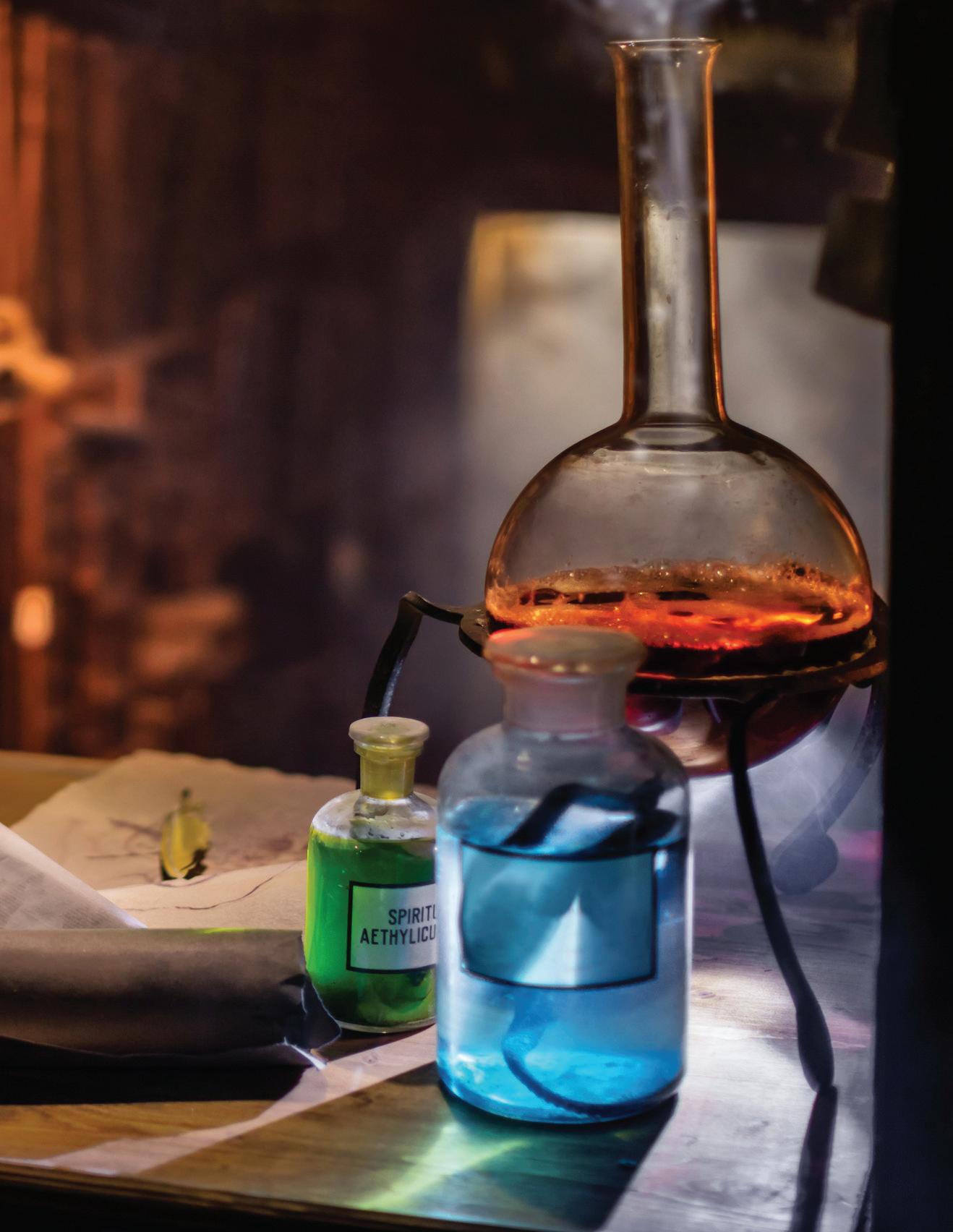

i nvented by Antoine Peychaud, a n ew o rleans resident, in the 19th century. This style of bitters is sweeter, floral and more citrusy than Angostura Bitters:
• 2 1/2 C. n eutral Alcohol, preferably 100-Proof (50% AB v ) or greater
• Peel from 1 o range
• 1/4 C. Fresh m int
• 1 or 2 Cardamom Pods
• 1/2 Tbsp. g entian r oot
• 1 s tar Anise
• 2 to 3 oz. d ried Cherries or Currants
• 3 to 4 e dible Flowers (optional)
• 1 C. w ater to dilute (optional)
Arrange your tincture jars. Place the orange, mint, and flowers in one, and the cardamom pods, gentian root, star anise, and dried cherries in the other. Add the neutral alcohol, seal both jars, shake them once, and let them sit to allow for the ingredients to infuse the alcohol. l et the citrus and floral jar infuse for two to three days, and allow the root and dry spices to infuse for at least four to five days.

s mell each jar once daily to ensure successful infusion. w hen they are ready, filter solid ingredients out with a mesh or plastic strainer. Check your bitters by adding them to a drink or consuming a few small drops. Combine the contents of the jars. d ilute with a little bit of water if needed.
g ot Rum? April 2023 - 38
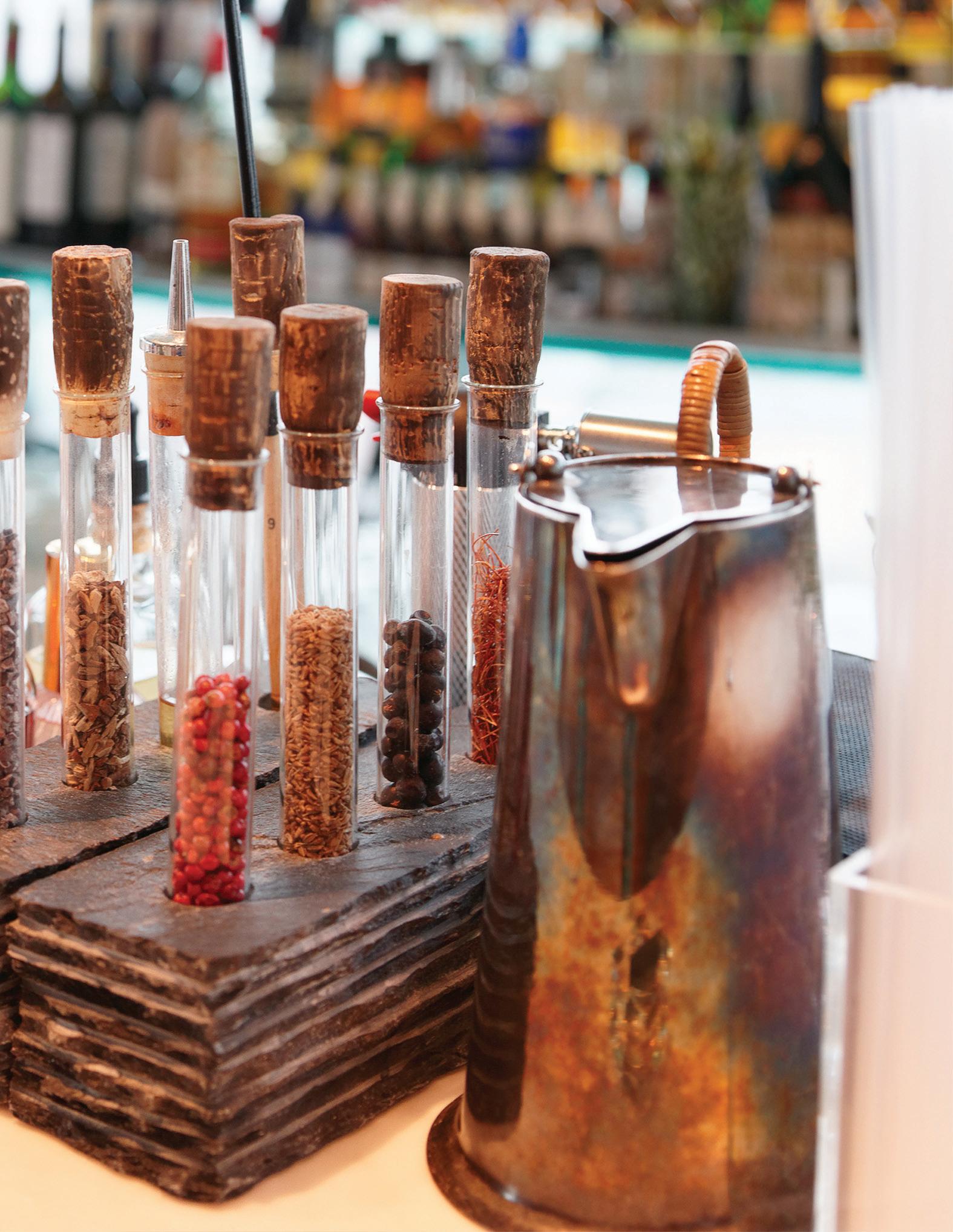
 by m ike Kunetka
by m ike Kunetka
to: m ike@gotrum.com.
Plantation r um has introduced s tiggins’ Fancy s moky Formula, a limited-edition aromatic twist on its iconic s tiggins’ Fancy Pineapple r um, giving it an extra maturation in ex-Teeling Peated s ingle m alt i rish w hiskey casks, for a distinctive and delicious smoky touch. i n his travels across the globe to explore the terroirs of rum and other fine spirits, owner and m aster Blender, Alexandre g abriel, loves to exchange ideas with fellow visionaries who share his insatiable curiosity. o ne such kindred spirit is Alex Chasko, m aster d istiller and Blender at d ublin’s Teeling w hiskey d istillery. h e is equally passionate about the possibilities of both traditional and innovative techniques in distilling and maturing spirits. Alex welcomed the chance to swap Teeling w hiskey barrels for Plantation r um casks and start experimenting! i n 2019, the “unconventionally i rish” whiskey brand released a special s mall Batch Collaboration aged in ex-Plantation r um barrels. For s tiggins’ Fancy s moky Formula, Alexandre chose s tiggins’ Fancy Pineapple r um to undergo a final maturation in 200-liter oak barrels that had previously stored Teeling’s peated single malt i rish whiskey; the moderate degree of peat imparts a beautifully balanced note of smoke, distinctive but harmonious with the fruit-forward rum. s tiggins’

These are the most recent and noteworthy headlines in the rum industry. i f you want us to share your news with our readers, please send me an email
Fancy s moky Formula adds an unexpected touch to cocktails and reveals its diverse, complementary origins when sipped neat. https://www. plantationrum.com/
gos LI ngs
n ot every country can claim an official cocktail, but Bermuda most certainly does, the d ark ‘n s tormy. r olling out through April, g oslings r um will introduce a new ready-to-drink ( r T d ) d ark ‘n s tormy canned cocktail portfolio with a trio of tropical flavors: Pineapple, m ango, and Black Cherry, which join the original d ark ‘n s tormy in a revamped can. e ach cocktail will be available in 355 m l 4 pack, canned at 7% AB v. The family-owned rum producer trademarked the d ark ‘n s tormy on June 9, 1980, to protect the signature cocktail’s integrity across the world, and to forever ensure that a cocktail can only be represented as an authentic d ark ‘n s tormy if it contains the key ingredient, g oslings Black s eal r um. The newly released d ark ‘n s tormy canned cocktails are made with g oslings Black s eal r um, g oslings s tormy g inger Beer and a hint of fruit flavor. The m ango variety offers a clean stone fruit flavor, Black Cherry is sweet and spicy, and Pineapple is refreshing and bright. All four varieties are made with no preservatives and are naturally sweetened with cane sugar. “ g oslings first released the d ark ‘n s tormy in a ready-to-drink format in 2012 and today’s consumer demand for convenient, high quality ready-to-drink cocktails motivated us to get creative,” says m alcolm g osling Jr., eighth generation rum maker. “Bermuda offers an island spirit unlike anywhere else, and now that fun-loving vibe can be easily transportable to boats, beaches, golf courses, hiking trails, or any other place where mixing isn’t ideal. The sweetness of the mango, pineapple, and black cherry pairs deliciously with the spiciness of the ginger beer so there’s a ‘zip in every sip’ (our favorite tagline).” https://www.goslingsrum.com/
i n honor of e arth d ay 2023, Copalli r um is continuing its Cocktails for A Cause program, which partners with bars, restaurants and retailers to raise funds for organizations which support environmentally responsible initiatives. The program will run during the month of April in honor of e arth d ay, April 22. d uring the month, participating accounts in California, Florida and n ew York will create cocktails using any of the Copalli r um expressions, w hite, Barrel r ested or Cacao. e ach cocktail will be finished with a custom garnish which can be taken home and planted to produce a bouquet of wild flowers. o n the back side of the garnish is a Q r code that explains more about the program and the organizations they are benefiting. For each featured cocktail that is sold during April at participating accounts, $1 will be donated to local charities such as Food Forward in s outhern California, Foodwise in n orthern California,
r ainforest Trust in Florida, and the Billion o yster Project in n ew York. Consumers unable to visit a participating account may also get in on the fun as Copalli r um will be donating $5 for each bottle purchased online during the month of April to the r ainforest Trust.
“ s ustainability is core to the dn A of Copalli r um, not just a marketing initiative,” said Brian Baker, C mo , Copalli us A. “ l ast year this program raised more than $7K thanks to the creativity of our partners in the hospitality community and the support of our fans. w e’re excited to re-engage with consumers and our partners in the on and off premise again this year to raise funds for local organizations while reinforcing the importance of being environmentally responsible.” https:// copallirum.com/cocktails-for-a-cause/
ARIZ on A R um DI s ILL e RI es WI n go LD A t
w hen i moved to Arizona three years ago, i thought i was moving to the great rum desert. l ittle did i know that we have two internationally acclaimed rum distilleries. This year, the i nternational w ine and s pirits Competition received rum entries from 48 countries. Combined, d esert d iamond d istillery and e lgin d istillery won 1 g old o utstanding, 3 g old, 3 s ilver and 4 Bronze m edals for their rums as well as 7 medals for other spirits. John Patt’s d esert d iamond d istillery’s g old m iner 11-Yearo ld r eserve earned 99 points, beating out Plantation’s Xaymaca, Black Tot’s Blender r eserve and h avana Club’s 15-Year- o ld g ran r eserva for the top rum and a g old o utstanding m edal. d esert d iamond also won 2 g old m edals ( g old m iner 10-Year- o ld r eserve and g old m iner r eserve), one s ilver m edal and 3 Bronze m edals for their rums. At the e lgin d istillery, g ary e llam’s 9 Triple 3 r um earned 95 points and a g old m edal. h e also won 2 s ilver and a Bronze m edal for rums in his r egalo d e v ida g ran r eserva series. i f you come to our state to see that canyon, i strongly recommend you visit these distilleries. John Patt and g ary e llam are passionate distillers and their rums are worth a try. https://www.desertdiamonddistillery.com/ https://www.elginwd.com/
The Kraken r um, emerges from its lair in the depths of the ocean to enter into the gold spiced rum category with a new release. i ntroducing T he new gold s TA nd A rd for sipping: a gold spiced Caribbean rum, rich beyond words and perhaps the only bit of lightness the legendary beast, known as “the Kraken,” loves with as much passion as its storied black ink. o n the nose, The Kraken g old s piced r um reveals a sweet brown medley of caramel, oak, and banana bread. Flavors of molasses and dark spice fade into
caramelized sugar, with a slight finish of toasted oak and vanilla. “As gold spiced rum occasions are now the highest among the rum category, we are proud to introduce this new offering from The Kraken, with a flavor profile all its own,” said l ander o tegui, s enior v ice President of m arketing at Proximo s pirits. “ w e are confident that this product will be T he new gold s TA nd A rd in spiced rum thanks to its superb taste that we know matches what our consumers are looking for.” A study conducted on the popularity of spiced rum brands showed The Kraken g old s piced r um as a clear category favorite. Proximo s pirits commissioned a third-party double blind taste test study against category competitor, Captain m organ®. The study revealed more than 70% of consumers prefer The Kraken g old s piced r um over Captain m organ o riginal s piced r um. Furthermore, participants also overwhelmingly indicated The Kraken g old s piced r um both has “superior taste” and is “the smoothest.” To bring The Kraken g old s piced r um from sip to screen, the brand is launching a new visual campaign, “Tale of g old.” The advertisement, directed by r ich l ee who’s known for his work on the first three The Pirates of the Caribbean films, draws consumers into the dark world of the Kraken. m oody, foreboding visuals divulge the action-packed narrative of unworthy pirates who try to steal the precious treasure of gold from its lair and are thwarted by the Kraken. Before it dives back into the darkness, The Kraken is celebrating its newly released g old s piced r um by giving consumers an opportunity to win a g olden h our experience in the d ominican r epublic. To enter The Kraken g olden h our s weepstakes for a chance to win a trip to the home of The Kraken r um, scan the Q r code or visit www.Kraken g olden h our.com
Travelers flying from Jamaica’s busiest airport, s angster i nternational in m ontego Bay, can now explore the world of APP le T on es TAT e Jamaica r um in a new high-tech, premium boutique just opened in the airport’s main duty-free store. A world-first for the rum brand, the shop takes shoppers on a self-guided, cane-to-cup journey into the heart of what makes APP le T on es TAT e such a unique Caribbean rum, seamlessly blending physical, multisensorial and digital elements. Customers navigate their way through the boutique via a series of interactive touchpoints that express the legend, craft and personality of the island’s iconic rum. The distinctive insignia of APP le T on es TAT e , formed of five national symbols of Jamaica, is the central feature of the store’s physical experience. i t has been brought to life as a stunning modernist 3 d copper sculpture in the center of the store; a magnet for shoppers to help them learn more about the brand’s origin and terroir. The insignia is the starting point for the shopper’s digital journey within the boutique. Travelers can scan the front label of any bottle with their mobile device to discover a detailed
description about the rum they have chosen, including individual tasting notes and a caneto-cup explanation of the distillery’s production process narrated by APP le T on es TAT e m aster Blender, Joy s pence, herself. “ w e are thrilled to open the APP le T on es TAT e experience at m ontego Bay Airport, just 50 miles from where our incredible rums are lovingly crafted,” said m arco Cavagnera, m anaging d irector of g lobal Travel r etail at Campari g roup. “ i t’s a perfect premium location to engage shoppers by showcasing every facet of APP le T on es TAT e its rich history, passion for natural ingredients, local provenance, the skill of our m aster Blender, Joy s pence, and the versatility of the award-winning portfolio created under her guidance, ensuring there is an APP le T on es TAT e rum for any elevated occasion, from premium cocktail-making to sipping rums.” https://appletonestate.com/
Bacardi welcomes back r oberto r amirez l averde as g lobal s enior v ice President, effective immediately. r oberto takes on an open role following the promotion of n ed d uggan to g lobal Chief m arketing o fficer of Bacardi and President of Bacardi g lobal Brands l imited. r oberto reports to n ed and joins the m arketing l eadership Team. h e will be based in Bermuda, pending authorization by the Bermuda d epartment of i mmigration. d uring his previous tenure at Bacardi from 2013-2019, r oberto contributed to building the premiumization strategy for the company’s aged BACARDĺ rums and FACUNDO rum collection. h e contributed to launching the iconic rum brand’s portfolio of premium, aged rums and building the architecture that continues to define the premium rum category. e arlier in his Bacardi career he led the r ums Category for l atin America and Caribbean r egion, originally joining Bacardi in 2013 as m arketing d irector for m exico. “ i n addition to being a brilliant marketer, r oberto understands the value of consumer mindsets, and equally important, he gets Bacardi,” says n ed d uggan. “ h e knows our people, our culture and brings a strong track record of collaborating that is key to continue unlocking even greater growth for the brand across the globe.”
“ i am thrilled to be back at Bacardi and to work with the incredibly talented team who has been building and leading the brand. Together, i know we will build Bacardi’s next great story,” said r oberto.
i n other news, BACA rd Í® r um has today announced the launch of BACA rd Í Caribbean s piced, the brand’s first premium spiced aged product, that blends spices with coconut, pineapple, and coconut blossom. i ts unique flavor profile makes it perfect for all your favorite Caribbean-inspired cocktails this summer. h itting supermarket shelves and bars nationwide from m arch, the new BACA rd Í Caribbean s piced combines the unique sweetness of coconut
blossom and juicy pineapple with cinnamon, vanilla, and the subtle oaky char from the barrel. Cocktail lovers can expect to be delighted with notes of caramelized pineapple and lightly toasted coconut – a feast for the palate that will transport you to the tropics with every single sip. w ith versatility at its core, Caribbean s piced is made for mixing. w hether it’s elevating a refreshing rum and cola, adding a twist to a classic with a zesty Coco d aiquiri or shaken up in a Caribbean Colada - rich with the flavors of cinnamon and pineapple, it’s set to bring the sunshine to any occasion whether you’re at home or enjoying it at a bar. Just mix and sip to taste the exceptional craftsmanship and tantalizing tropical flavors. o r for purists, BACA rd Í Caribbean s piced works wonderfully neat. “ w ith summer just around the corner, we’re delighted to launch BACA rd Í Caribbean s piced. i t’s the first of its kind in our range – a perfect blend of aged rum, coconut, pineapple, and warming spices working harmoniously together to create a balanced, smooth taste experience. w e know that there is growing desire for classic tropical drinks as well unique flavors and aged rums,” says d ickie Cullimore, g lobal Brand Ambassador for BACA rd Í. “ m aking its debut in the u K, we’re looking forward to taking the nation’s tastebuds on a trip to the tropics, to be enjoyed not only by long-time rum drinkers but converting some new fans with its unique combination of spices and Caribbean flavors.”
https://www.bacardi.com/
Last month, Kō Hana launched their ready-todrink m ai Tai in their tasting room and online. The m ai Tai is a perfect balance of rums, lime, orgeat and orange curaçao. As a true cocktail, it is bottled at 22% AB v. and perfect to pull from your refrigerator to pour over ice. g arnish the glass with a pineapple spear or sprig of mint and you’ll instantly be transported to the sandy beaches of o ahu. m ark your calendars for the April 8th launch party at the distillery. s ee page 48 for my interview with Robert Dawson, co-founder of Kō h ana. https://www.kohanarum.com/
Pusser’s r um has introduced a 12 oz. (355ml) canned ready-to-drink ( r T d ) version of the Painkiller, a storied cocktail originated from the British v irgin i slands and now known across the globe! The Painkiller Cocktail originated in the early 1970’s at the tiny, 8-seat s oggy d ollar Bar, at w hite Bay in the British v irgin i sland. i t was located on a long stretch of desolate, uninhabited white sandy beach, protected by a coral reef providing a cozy anchorage for visiting yachts. The s oggy d ollar was so named because there was no dock; you had to swim in to get to it. i t was owned by d aphne h enderson, a delightful
and witty, middle-aged e nglish lady. o ne s unday, Charles Tobias, the Pusser’s founder, and resident on the nearby main island of Tortola where he was bottling Pusser’s r um, paid a visit to d aphne and the s oggy d ollar as he was curious to see what she was doing with the prodigious amounts of Pusser’s r um that she was regularly ordering. Tobias was duly impressed with the constant flow of patrons who would anchor and swim ashore just to imbibe her delightful cocktail creation “The Painkiller”! Tobias and d aphne became good friends, and both agreed that the only rum that worked with the drink was Pusser’s because its full rich taste could punch through the scintillating mix of cream of coconut, pineapple, and orange juices of the Painkiller. i n time, d aphne promised to give Tobias her recipe, but always found an excuse to not do it, so he came up with his own recipe. o ne afternoon, they compared the two at a competitive tasting which d aphne had arranged at the s oggy d ollar with eight patrons. Tobias’ recipe won by a score of 8 to 0! w ith d aphne’s blessing, so long as he credited her with the drink’s creation, he trademarked the drink – and began to promote it at every opportunity in the us and i nternational markets. https://pussersrum.com/
r enegade has announced that their online shop is now open, offering a direct link to all available r enegade r um bottlings, both Pre Cask and oakaged Études. Available in very limited quantities in e urope, these first bottlings are an invitation to the curious to join them in their search for rum’s ultimate profundity. For those of you in the us A and beyond, worry not, the rums are about to go on sale in select states. But for those of you in e urope, you now have the opportunity to purchase two newly launched Études from their favorite terroirs of the n ew Bacolet and Pearls farms. n ew Bacolet is enclosed and sheltered by a forest at its north, and slopes down towards the south. Being based along a mountainside, steeper than most of their farms, the excavation of the land was the most difficult. Four terroirs were identified over 10 acres, and they initially planted the varieties of Yellow l ady and l acalome r ed. o n the coastal plain, a stone’s throw south of the distillery, there is an intriguing terroir between mangrove and water meadow, with at its center a distinctive bank of iron-rich volcanic laterite. Cane grows vigorously on this water-retentive soil, derived from w oburn & Perseverance Clays. w ith a slight elevation in reference to the coast, the air that washes across Pearls is cool. This, in conjunction with a swamp touching the base of the farm, allows for a rich maintenance of waterretained soil. Amidst the towering palm trees, Pearls has been planted with the varieties of Yellow l ady and l acolome r ed.
r enegade also offers nine un-aged, Pre-Cask rums. https://renegaderum.com/

The r um u niversity® is proud to announce the date for its next 3-Day Rum c ourse , which will be offered at m oonshine u niversity’s state of the art facility in l ouisville, KY.




This course is designed for both existing and future rum distillers and brand owners, the 3-day workshop combines theory and practice to provide attendees with a practical, hands-on education on all things rum. From the financial, marketing, and regulatory considerations to the distillation, aging, and blending processes, every student will leave this course with a nuanced understanding of rum production, the spirits business, and how rum fits into the global, economic landscape.
o f course, you won’t miss out on any of the fun stuff: you’ll get to explore the science of rum production while getting your

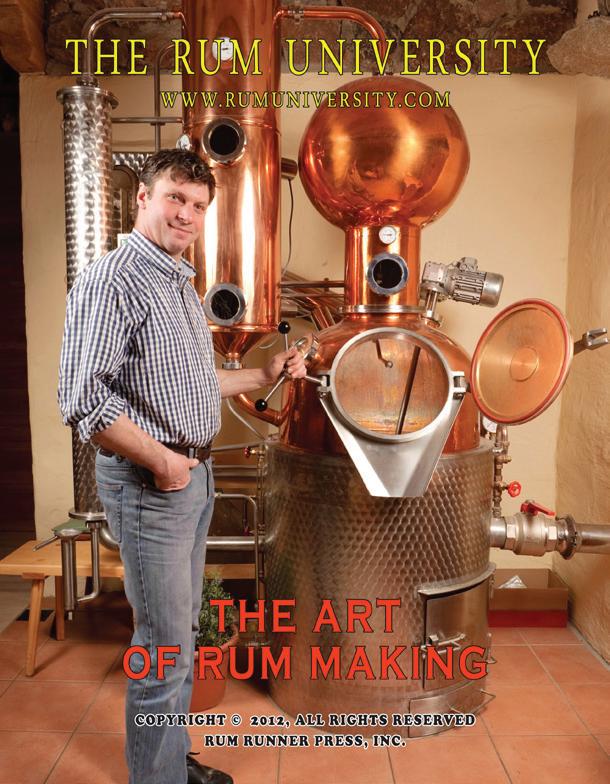

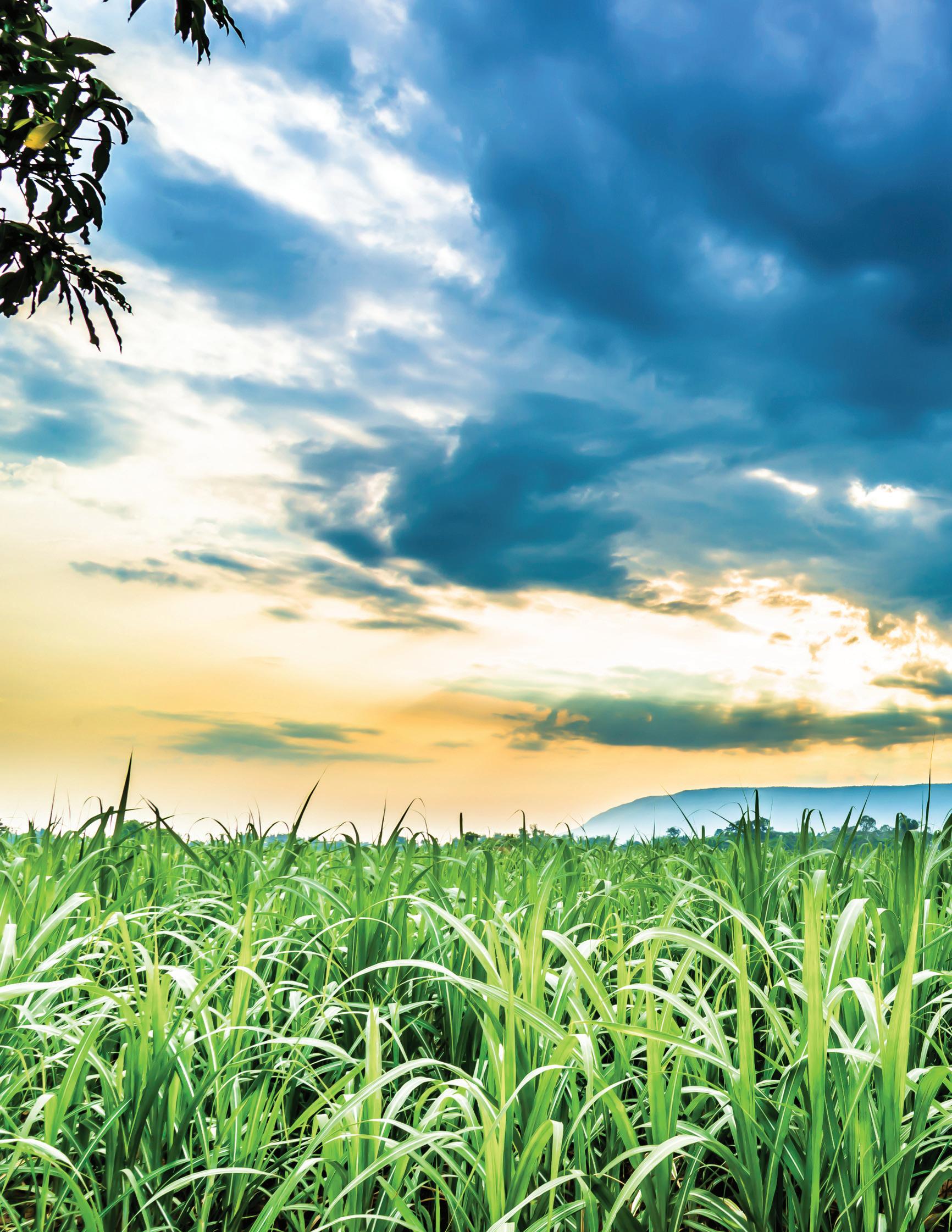
d id you miss out on the last course?
d on’t let it happen again!
v isit gotrum.com and sign up to receive notifications for future
r um u niversity® Courses.

www.Rum
hands dirty distilling at our oncampus facilities. w e’ll also explore the history, category styles, and production methods for rum, as well as its mash bills, fermenting, distilling, and finishing processes. w ith rum tastings and sensory training sessions set up throughout the course, you’ll discover a variety of rum expressions and styles, and get a feel for the versatility of this delightful spirit.
w hether you’re a seasoned rum distiller or newbie to the business, this class is for anyone who has or is planning to open and/or operate a distillery; production team members (blenders); and anyone else interested in refining their knowledge of rum production.


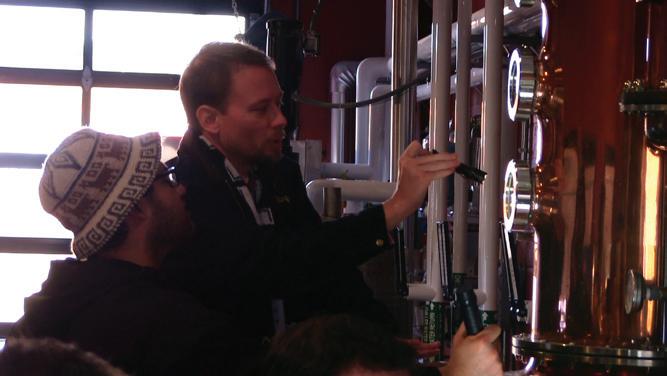



This class is co-taught by l uis and m argaret Ayala, Co-Founders of t he Rum u niversity® and g ot Rum? m agazine.






The r um u niversity® is responsible for in-person teaching of the Rum c urriculum of the 6-Day Distiller c ourse offered by m oonshine u niversity at their state of the art facility in l ouisville, KY.

The 6-Day Distiller c ourse is designed not only to give the most comprehensive technical training and business management education in the industry, but also to offer participants social and networking opportunities with other participants, suppliers, industry professionals and world-renowned master distillers.
The r um section of the 6- d ay d istiller Course covers the following topics:
• r um definition (technical, legal, chemical)
• Alcohol congeners, quantifications and differentiations
• s ugarcane origin, cultivation, harvest and processing

• Business and economic aspects of the rum industry
• o rganoleptic assessments of rum via tasting exercises
• o verview of fermentation, distillation, aging and blending
• h ands-on distillation equipment experience
• Q&A
To register or to check for availability, please visit their website at www.moonshineuniversity.com. These are the 2023 dates:

• m arch 26-31, 2023
• m ay 21-26, 2023
• July 23-28, 2023
• o ctober 22-27, 2023
c lick on the images to go directly to the ordering page. If that does not work, copy and paste the links into your browser:
t he Rum Laboratory: https://www.magcloud.com/browse/issue/2140141


t he Rum Biography: https://www.magcloud.com/browse/issue/2139570
Rum Aging s cience Vol1: https://www.magcloud.com/browse/issue/2140574




f ermentation Primer: https://www.magcloud.com/browse/issue/2139000
Ideas t hat c hanged t he Rum World: https://www.magcloud.com/browse/issue/2140228
Rum Aging s cience Vol2: https://www.magcloud.com/browse/issue/2140576
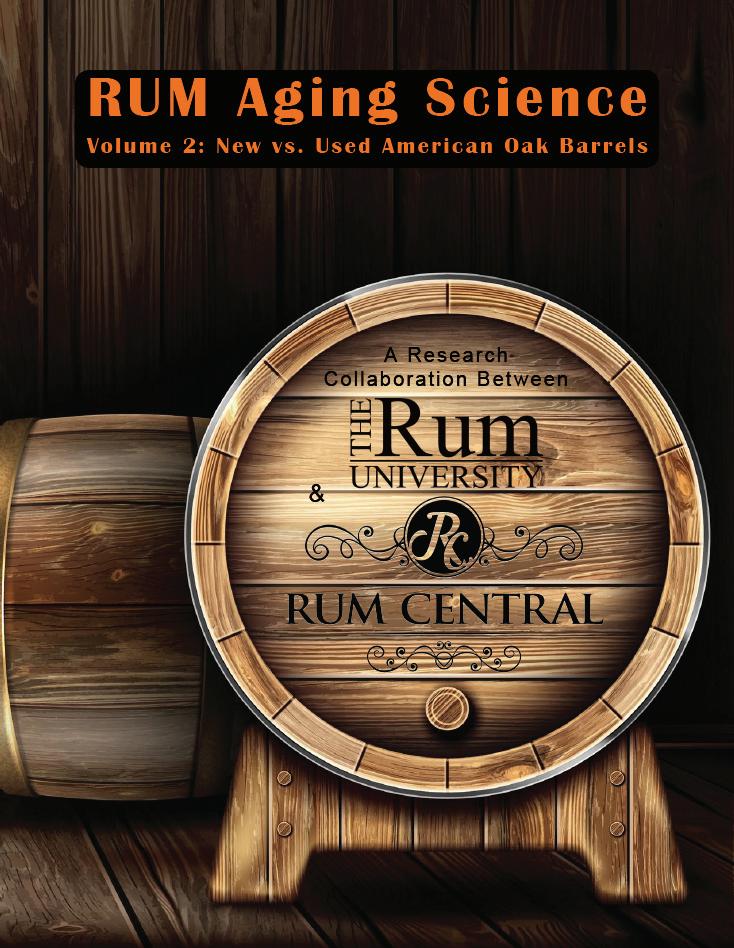
l ast d ecember, my family took our long-awaited vacation to h awaii. w e spent the first half of the trip on the Big i sland of h awaii and now we are on o ahu. w e avoid the craziness of w aikiki and stay at a big family resort of the e astern side of the island. l ast night we had dinner across the street at Peter m erriman’s m onkey Pod r estaurant, where we had great food and many of their wonderful m ai Tais, a nice riff on the Trader v ic original with Passion Fruit foam on top. Today, the grandkids are zipping down water slides, the adults are recovering and i am driving north to Kō Hana Distillers in Kunia. In 2009, Robert Dawson and Jason Brand created Kō Hana with the understanding that they would make rum from fresh cane juice and that juice would come from h awaiian heirloom sugar cane that they would grow on h awaii.
- m ike Kunetkag ot Rum? April 2023 - 48

Kunia, or Kunia Camp, as it was once called, was originally the plantation village for a d el m onte pineapple operation. These days, the plantation is home to several agricultural startups, including Kō Hana. As you pull into the property, you can just barely see the top, curving roof of an old Quonset hut. The hut was built in 1959 and served as the g eneral s tore for the d el m onte plantation. i t was completely refinished in 2015 and now serves as the Kō h ana Tasting r oom. i t is here that i meet Jennifer s andage (J s ), Assistant m anager of the Tasting r oom and the guide for this morning’s farm tour and tasting.
J s : In Hawaiian, Kō means cane and Hana means work. Our name actually means the work of the sugar cane. The way we do that here at Kō Hana is we make agricole style rum, using the fresh pressed juice as our main ingredient.
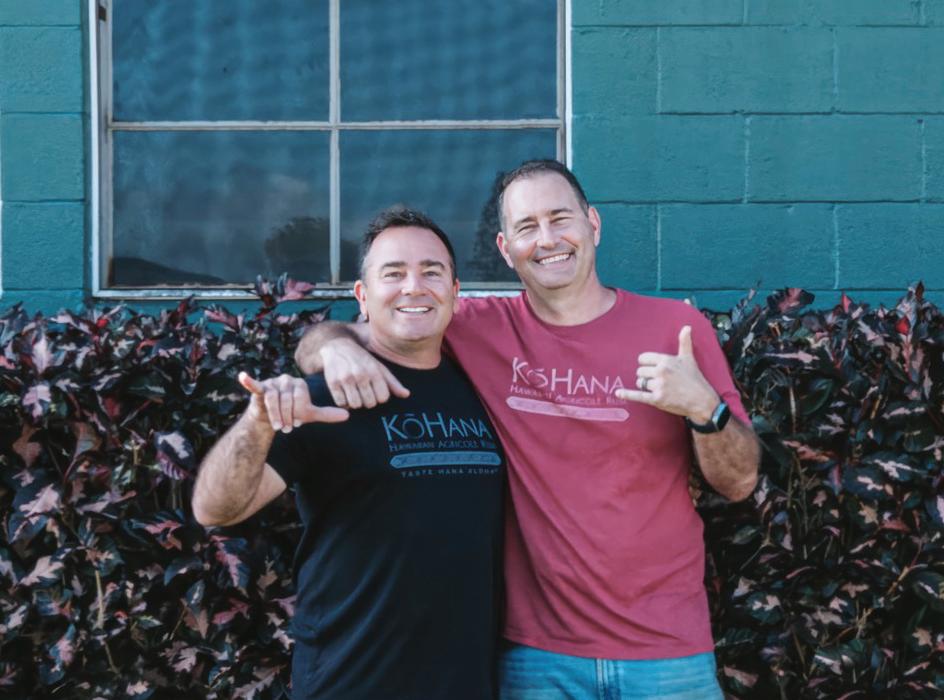 Jason Brand (L) and Robert Dawson (R), Co-founders of Kō Hana Distillers, Hawai’i.
Jason Brand (L) and Robert Dawson (R), Co-founders of Kō Hana Distillers, Hawai’i.
We differ from traditional rums that use a sugar by-product, like molasses. We are going to start our tour by trying a little of the beautiful sugar cane juice.
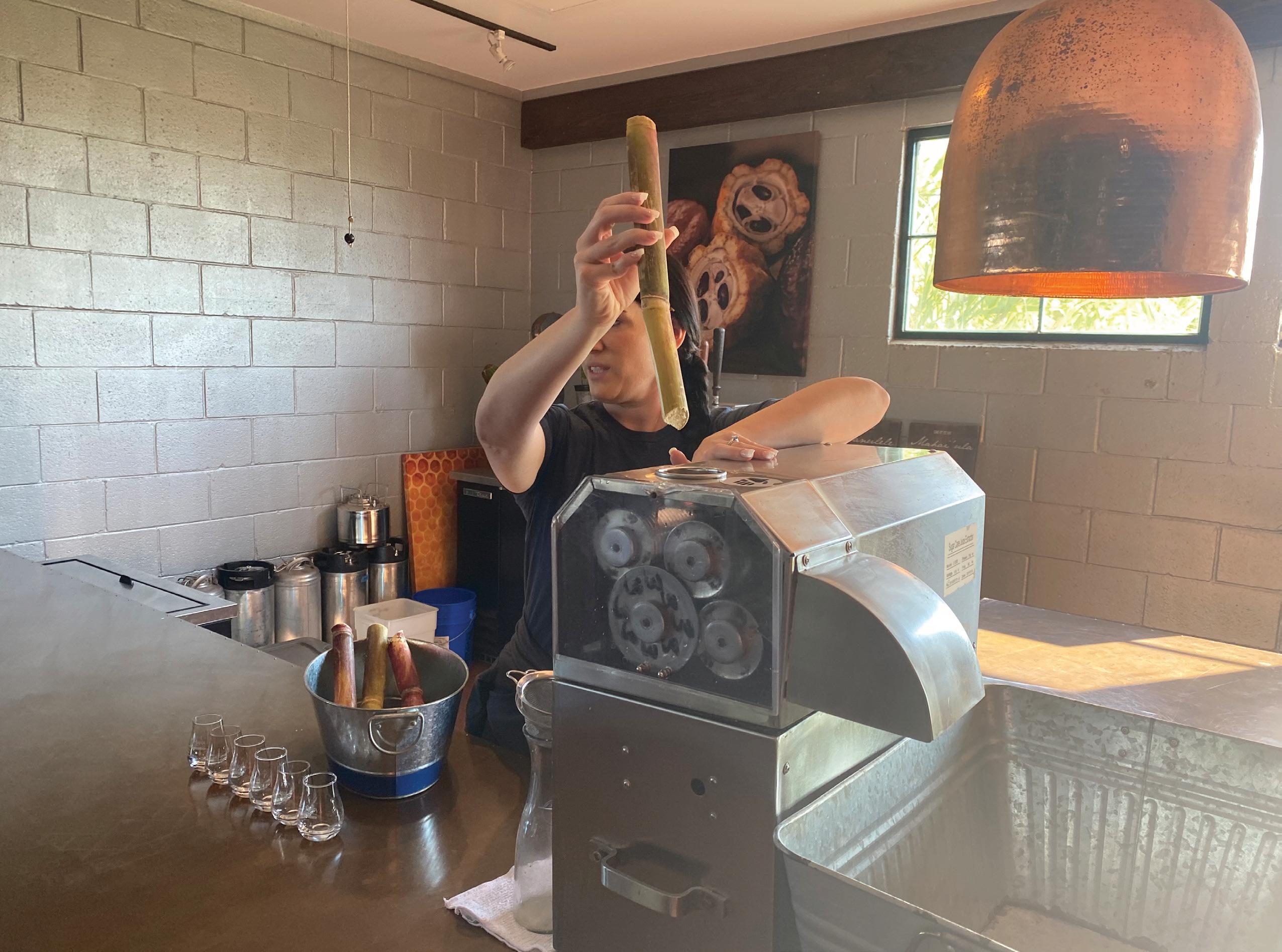
Jennifer pulls out several short pieces of cane from a refrigerator and feeds them into a beefy, table-top crusher. The machine pulverizes the cane, sending the spent pulp in one direction and the fresh juice into a cup. Jennifer then pours each of us a sample. The liquid is milky white, the aroma is very floral and the taste is a combination of bananas and coconut water.
The next stop on our tour is the Cane g arden. Just outside of the Tasting Room, Kō Hana has planted samples of the 34 h awaiian heirloom varietals they have collected. The variety of varietals is stunning, from milky white to yellow to reddish-purple. Jennifer points out a couple of varietals that are used in rums that we will soon taste. There is Kea, which means white in h awaiian, because it has a white waxy finish. n ext is m ahial’ula, ula meaning red, has a red
stalk. Jennifer then points to m anulele, a purple cane, that was the first cane that d awson and Brand used in their early experiments in 2014.
w e leave the garden and start the short hike to the cane fields. The d el m onte plantation had about 3,000 acres at one time. w hen it closed in 2006, the land was sub-divided and leased to several start-up companies. o ne is Kunia Country Farms, where Kō Hana partner Jason Brand has an ingenious aquaponic lettuce farm. l arge tanks hold tilapia fish and the water from those tanks is used to spray and fertilize the roots of gourmet lettuce. They are currently harvesting 5,000 heads of lettuce a week.
Just past the lettuce farm, the cane fields begin. i t is impressive to see these colorful, 15-foot plants, towering over you. u p ahead, three workers are feeding cane stalks into a large crusher on wheels. n ext to the crusher is a large, spherical tank. After the stalks are crushed, the pulp or bagasse is thrown in a big pile and the juice is pumped into the tank.
JS: We like to harvest and crush on-site because we use all aspects of the cane. We will strip the leaves from the stalks and use them as a natural weed mat. All these pieces of black plastic you see here in the field were from the Del Monte days. They would use large sheets of plastic for their weed mats. We will compost all the crushed cane and return all those nutrients back into the soil. Out here in the field, it might take us several hours to crush a day’s harvest. To prevent wild yeasts and bacteria from taking over, we inoculate the juice here in the field with our proprietary yeast, giving it a jump start on fermentation.
On the way back to the Tasting Room, we pass the distillery buildings. The smaller building has the 25-foot column of a continuous still extending through the roof. The second building has two hybrid pot stills. The first consists of a 600-gallon pot connected to a column with four plates. This was the main still for several years. The newer still is larger, it has a 1300-gallon pot, with two columns, each with ten plates. So many stills, so many questions!
From here we move back inside for the tasting. Kō Hana has two core products and several special releases. The first core rum is Kea, their un-aged white rum. Every batch of Kea is made from one heirloom varietal, each with its own flavor notes. Koho is the aged version of their rum, having been rested in barrels for 2 to 3 years.
g ot Rum? April 2023 - 50

We line up at the bar and Jennifer begins to pour.
JS: Kea means white in Hawaiian. Kea is our white rum. After it comes off the still at 160-proof, we are going to rest it for 90 days in stainless steel tanks. The resting period gives all the components time to merge. Then we will bring it down to 80-proof (40% ABV). Today we are tasting Kea made from the Pilimai and Mahaiula varietals.
After a chorus of oohs and aahs, Jennifer moves on to Koho.
JS: Next is Koho, which means to select or choose. We will take our distillate down to 118 proof and put it in a variety of barrels for 2 to 3 years. This sample is from the Ko Kea varietal and was aged in American Oak and bottled at 90-proof.
Now Jennifer brings out the special releases. First, we sample Koa, an aged rum that has spent additional time in special casks made from Koa, Hawaii’s most famous endemic hardwood. It gives the rum an interesting reddish hue. This Koa is made from the Kea varietal and is bottled at 100-proof.
The next special release is Kila, which is the Hawaiian word for strength. Kila is only bottled at full cask strength. The proof is variable and handwritten on the label. Today’s sample was
made from Mahai’ula cane, aged in American Oak and bottled at 118-proof.

The last limited release I tasted was a 100-proof version of Kō Hana’s white, unaged Kea. This comes in a special etched, numbered bottle and is made from Manulele cane.
These last two, higher proof offerings were definitely my favorites and I had a bottle of each shipped back home. The white makes a perfect Tí Punch and the Kea is a wonderful sipper.
As I was checking out at the counter, Jennifer was nice enough to introduce me to Robert Dawson (RD), one of Kō Hana’s founders. We talked briefly and I mentioned that “Got Rum?” had interviewed him several years ago and that I would like to do an update article. He was needed in the distillery, but gave me his card and told me to contact him if I had more questions. And did I have questions!
MK: For those of our readers that are not familiar with your discovery of Hawaiian heirloom sugar cane varietals, can you tell us how that came about?
RD: I moved to Hawaii in 2008 with my wife and son and immediately decided to switch gears professionally. I ran a technology consulting business, but I wanted to do something more tangible. Hawaii’s rich agricultural history intrigued me and I started brainstorming ways to tie agriculture, tourism, and consumer products together in a way that would create something new in my adopted new home. That journey led me to the Hawaii Agriculture Research Center (HARC) where I was introduced to the vast number of plants grown in Hawaii by two of the world’s great experts in the field, Stephanie Whalen and Bob Osgood. Their vast library of reading materials going back 150 years set in motion the path that became Kō Hana. As I studied sugar cane growing in Hawaii, I learned that sugar cane was already here prior to contact with the West. The earliest Polynesian settlers brought it to Hawaii in their voyaging canoes and it held very significant cultural, medicinal, and spiritual values for them. At this point I did not know that it wasn’t grown commercially, but it quickly became apparent that if I wanted to start a business using these amazing canoe plants, I would have to start farming. The good people at HARC guided me initially. They told me where

I could find the different varieties of sugar cane on Oahu and I went to collections all over the island. At the Waimea Botanical Gardens, while asking for samples from their excellent collection, they told me I needed to meet a guy named Noa Lincoln. Noa grew up in Hawaii and was working on his Doctorate in Ethnobotany with a focus on Hawaiian plants including sugar cane, called Kō in Hawaiian. We met and became friends with shared passion to find all the varieties of Kō throughout the islands. His hard work and guidance were instrumental in building this company from the ground up, literally. At the same time, I met my business partner, Jason Brand. He had also moved to Hawaii in 2008 and our children went to kindergarten together. I told him about my plans and we became business partners and built the business together.
MK: You and Noa Lincoln collected all these varietals and start growing the cane. Now you have enough stock to create cuttings to plant a farm. How did you end up in Kunia?
RD: The property where we built our Tasting Room just happened to be the semi-abandoned Del Monte general store across the street from the HARC offices where I was gathering research for this project. Del Monte had closed its business in Kunia entirely by 2006. The general store was the center of the agricultural village in Kunia. It had a post office, barber shop, grocery store and lunch restaurant. The building and surrounding land were a mess when I came upon it, but it immediately caught my eye and I thought it would be a perfect place to build the distillery. Working with HARC, we leased the property and spent years bringing it back to life.
MK: You started with 30 acres in Kunia and now you have 300 acres?
RD: That is correct. We have four separate locations. The vast majority of what we grow is on the North Shore, in Haleiwa and Waialua. Of the 300 acres we have, 260 are up there.
MK: That would bring up the question of terroir. If you were to plant the same varietal at all four locations, could you have different results?
RD: We have seen that already. Kunia is in central Oahu, higher elevation, fairly dry, easy to control moisture and things like that. Kunia is far from the ocean. At the North Shore we are obviously very close to the ocean. The salt breezes are blowing on the cane all the time. We know there is an actual difference in everything we do down there, there is an
actual salinity to it, just from the salt air. The prevailing winds blow all the time and you can see the mist blowing off the ocean, particularly in the winter, when the big waves are up. You see a blanket of sea mist coming up over where we are in Waialua, which is very much at sea level. Haleiwa is more on a slope.
MK: You only make rum from one varietal at a time. How many varietals were you and Noa Lincoln able to find and how many have you harvested to make rum so far?
RD: We have experimented with 11 different varietals of Hawaiian Kō at this point. Eventually, we want to make at least small batches from all 34 varieties we have acquired.
MK: You have all these different variables: different varietals, different farms, different soils, different climates, different seasons, different years. With all these variables, do you try to keep fermentation and distillation as consistent as possible?
RD: Yes, we do. For example, this year has been much wetter than last year and it’s really had an impact on our yields. We try to maintain our processes and those processes have been developed over time. We have now come to understand that different canes distill slightly different and we vary our heart cut based upon that. We understand that Mahai’Ula, for example, is a very rich and robust, I would almost say earthy, cane. The juice of it tastes very different than Kea, which is grassy and sweet and tastes like sugar cane. Mahai’Ula has a much earthier and wet moss taste to it that’s in the juice itself. That character makes us distill it much differently. Kea is so semineutral that we can distill it at a pretty low proof to get a lot of flavor. The most recent Mahai’Ula that we got in, not only is it very earthy, but it is low brix, which is unfortunate. We didn’t have a good yield on it and the brix on it is around 14-1/2, which is almost the cost of making rum at that point. The energy costs almost make it not worth doing. It doesn’t have that much sugar, but it has a ton of juice and a ton of flavor. We tend to distill it at a higher proof, otherwise it is just overwhelmingly strong. What we try to do is to create what we call Hawaiian Agricole, which is our style, which is a single varietal using heirloom cane where we can highlight the nuances and differences without them swinging so widely one way or another.
MK: I don’t think people really appreciate how much goes into making agricole rum. Can you give us an idea of yields. If you were to go out
and harvest an acre of cane, how much weight would that be and how much juice would you get?
RD: Right now, we get about 25 tons per acre. We extract juice at around 70%. In other words, we get about 70% of that weight in juice. So, approximately 4,000 gallons per acre.
MK: When I was on the tour, Jennifer showed us the crushing machine. Are you still harvesting by hand or have you gone to machine?
RD: We are. Until we bring in the new equipment, everything is hand harvested. We are getting a mechanized harvester that will cut the cane into 18-inch sections called billets. That style mill that you saw in the field is a small crusher with a single set of three rollers. It is designed to be hand-fed long cane. The mill we are getting is conveyor fed. We will be able to just dump those 18-inch billets right on the belt that goes into a pre-shredder and a 3-stage juicing process. That will take our 70% yield right now up to over 90%. If you touch the waste matter that is coming out of our mill right now, it is still a little damp. The machine we are getting, the output is like sawdust. It gets every bit of juice out of the cane. That won’t be until probably August when we will start doing the mechanical harvesting. It won’t be any reduction in farm staff, it will mean different jobs for different people. In order for us to scale right now, we will keep all of our same crew, but we will have more people to do maintenance, more people to do field expansion and all the things that fall through the cracks. Farm labor is really hard to find; qualified farm labor is just not what people do anymore. Right now, we cut and harvest cane 5 days a week. Once we go mechanized, it will be 3 days a week and we will only be cutting every other week. Until we scale up, during those down times, we will be able to check the fields. It is easy to check 15 or 20 acres of drip tape. It is a lot harder to check 200 acres. You need drones, you need huge ATV’s to drive through and really look and make sure there are no dead spots. The equipment we have on site can do what we want to do as far as making rum and the volume we want to make right now. Now it’s all about getting the farm mechanized and operational to do this much juice. We are talking about 26,000 gallons a week. And that will all be done in 3 days. Imagine that. You are literally going to haul off 26,000 gallons of juice, which is like a small swimming pool every 3 days.
MK: You cut the stalk, but because this is a grass, it grows back?
RD: Correct. But because these are not commercial canes, there was not a lot of data on how long you could do that. You have to eventually replant. A cut of the cane is called a ratoon; that means you cut the cane and it regrows. I have heard that in some parts of the world, you can get 10 ratoons, you would replant every 10 years. Again, we are growing heirloom canes. We find now some of the varietals need to be replanted as soon as 3 years. That first year we get good rich sugar content, let’s say 18 brix. We found that in the second year, we might get 20 or even 22 brix. The second year is better than the first, which is actually typical of sugar cane. The first regrowth, the first ratoon tends to have your best yield. The third year, you might go back to that first year and then it slowly decreases to where you might only see 14 brix. Some of the problems we are having with our Mahai’Ula is that we are in our fifth year, our fifth ratoon and we have never done it before. No one has ever grown ten acres of Mahai’Ula before and cut it every year and see what happens. So, we are having to learn. We think we may have to replant every three years. We don’t have to replant Kea but every five years. Every different varietal has a different character and characteristics that we have to be mindful of. There are so many variables in what we do.
MK: The biggest problem with cane juice is that every bacterium and wild yeast on the cane and in the field wants to eat it. Jennifer explained that you are adding yeast to the juice in the field. That’s such a smart idea.
RD: We started inoculating in the field and it has made such a difference. We decided what the heck, let’s just teach the farm hands this is how much you add and it’s brilliant because not only are you inoculating it from all the wild yeasts and bacteria, but the pumping into the tank vessel is adding so much oxygen into the yeast wash that it couldn’t be happier. And it is warm out there, so between the heat and the oxygen, we are really getting it started. By the time it hits our fermenters, we see super active bubbling going on.
MK: You have cut the cane, brought it to the distillery and now it is fermenting. You mentioned 24,000 gallons of fermenting capacity. That sounds like a lot.
RD: It is a lot. We have yet to approach filling those, but in August we will. In August we will have all of those active. We are typically filling our fermenters between one and two thousand gallons. They are 3400-gallon fermenters but we are not filling them all the way because we
are not getting that much juice in any given day. We are over capacity in our fermenters.
MK: You have cut the cane, crushed it, fermented the fresh juice and now you have a wash to distill. What has been the progression of your stills?
RD: Our company was really a bootstrap entrepreneurial venture. Jason and I started with just the two of us sharing expenses. We eventually brought in outside investment, but it was small for what we were trying to do. So, I looked for a bootstrap still maker and found one in Steven Cage of Cage & Son’s. He was just starting out back then, too. So far, he has built four stills for us. Our first still was a 500-gallon pot with a 4-plate column and it was designed with his assistance to create something that could make the agricole style we were after in a single pass, rather than multiple runs. At the time, I think this was one of only two stills he had ever built of that size. He has been our go-to still maker ever since. We phased out the original 500-gallon pot for a more efficient 600-gallon unit and then built a 1,300-gallon pot with two 10-plate side columns, which is now our primary still. Once the farms are fully
online by the end of this summer and we are harvesting 6,000 gallons of fresh cane juice a day, we will change our process and start using the continuous still Steven built for us and do a two-stage process. We will use the continuous column as a stripping still and the 1,300-gallon pot as a spirit still. Cage & Sons has been a great partner for over 10 years now. He has grown with us and I think he can build anything we need.
MK: His website describes your continuous still as “a Continuous stripping column, capable of distilling 3,200 gallons of wash to low wines in 8 hours or less.”
RD: So that was the design, one fermenter per day. Then we will distill it again, because that is only bringing it down to low wines. Let’s say it was a 10% wash, we run it through the continuous still and we will bring it up to a 60% wash. Then we would put that in the big pot still to do the spirit run. The yields will be much higher, because we are starting with a much higher alcohol wine, which means it boils faster. The size of your cuts is going to be the same. You are probably going to get between 43 and 52% yield. But you are starting

with 50% alcohol and not 10%, so, you get five times more production and it’s much more energy efficient.
MK: What proof is the rum when it comes off the still(s) and at what proof does it go into stainless steel tanks or barrels?

RD: Because we grow our own cane and the varietals vary so much in flavor and sugar content, we don’t distill every varietal the same way. A low Brix cane tends to be funkier than a high Brix one. To even them out we might distill as high as 170 proof for part of a low Brix run, while we might never get above 160 proof on a high Brix run. When doing barrel runs, we could be distilling in the 140s. Again, the decisions are sensory and we have learned the sweet spots over the last 10 years of doing this. So, the short answer is 140-170 proof for rum making. We barrel at 118 proof.
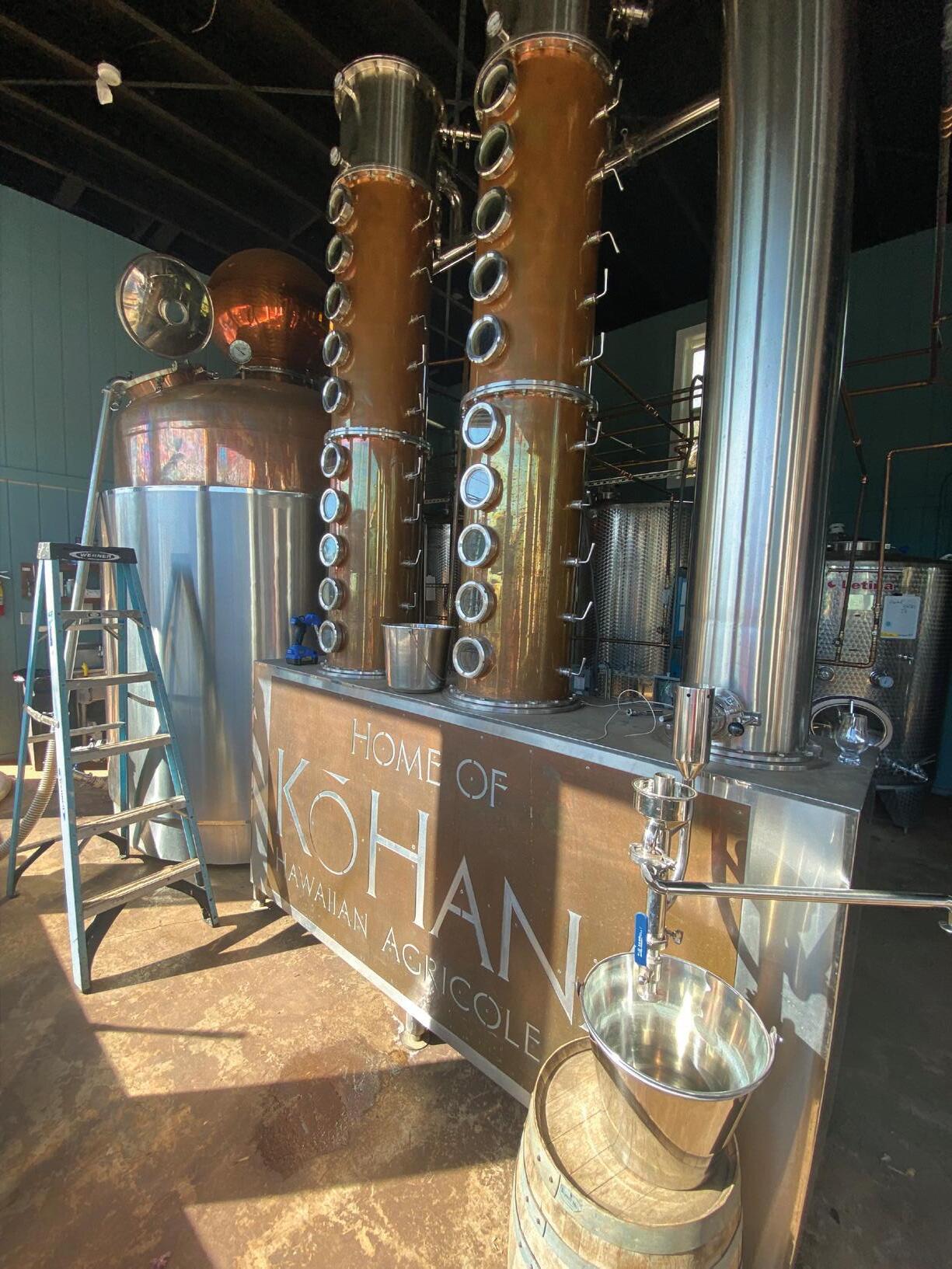
MK: Now you have spirits and you are aging it. I see you have used various woods for your barrel. The one that sticks out is the Koa wood. How do you find Koa wood, since you can’t just cut down a Koa tree in Hawaii and how did you find someone to make a barrel out of it? No one has ever done that before.
g ot Rum? April 2023 - 56
RD: We worked with a very interesting company called Continental Craftsmen and I definitely want to credit them. Seth Gonzalez is the name of the guy who has made our barrels and he is a very talented wood worker. We pull all of our Koa wood, mainly, from the Big Island. That’s where most it is and it is all from fallen timber. We don’t take any fresh lumber. Seth is really good with Koa. He understands the wood well and he is good at looking at the grain. He started from scratch with us and it has been a process. The first barrels leaked like a sieve. Koa is an endemic acacia wood that doesn’t bend well. It is much more rigid than oak, it wants to snap more than bend. He has been steaming it and doing everything he can, but like everything else we do, we took on something that’s really hard and trying to figure out how to do it. I feel like our techniques are good and the barrels coming out now are stable. We would like to go from the 30-gallon barrels that we are using right now to bigger, 50-gallon barrels. We started with a smaller barrel and, again, we are just going to grow into it and learn as we go. Koa rum will always be a boutique product, because there is a scarcity of Koa wood. Maybe it will always be special and you will have to come to the distillery to get it.
MK: You have gone from a barrel house that would hold 200 barrels to a new house that will hold 1000?
RD: That’s correct. Now we just have to fill them. We filled eight barrels last week, so that was a good week. Once we figure this full system out, we hope to fill eight barrels every week. The minimum age of any product we put out is two years, so, we really have to start building up that inventory.
MK: Then it is time to bottle. Kō Hana’s square bottle is very distinctive on the rum shelf. How did that come about?

RD: My concept was that I wanted to do a square bottle, a true cube. Nobody made one, so, we had to go through the process of making our own. The reason for it is kind of interesting. Being in the Pacific, we are the gateway to Asia. I think we have a tremendous growth opportunity in Asia, where rum is under-represented and underappreciated. When I started this company with Jason, the idea was to use Hawaii as a bridge to introduce rum into Asia. That means starting in Japan where the people have a huge affinity for Hawaii. When I was thinking of packaging, I was trying to create something that was special for what the Japanese would call ‘omiyage’, which is a gift. If you are a Japanese person and you travel, one of the responsibilities you have culturally is to bring back gifts to people who didn’t travel, whether they are your friends or your colleagues. The idea is that if you went somewhere special, you should bring something back and show your friends, family and colleagues what that was. Most Japanese, if they go on vacation for a week, two days will be shopping days, just to buy gifts for friends. If you meet a Japanese business person, they will present you with a business card and they will present it with two hands. If they give you a gift, they will give it with two hands. I wanted to develop a package that worked really well being given that way. It lends itself to being gifted with two hands. That’s really where the cube idea came from.
MK: It sounds like you guys have accomplished a lot in 14 years.
RD: I could not have done this without Jason Brand. I may have done more of the heavy lifting but he backed it, he made it happen. That’s how we started the company together and we are toe to toe working hard every day. From the beginning I was like ‘You are the
banker and here is the idea. Make sure we don’t run out of money and I will make sure we make great rum.’ I could not have done it without Noa Lincoln, HARC and those other people, but particularly Jason, my business partner. I just want everyone to understand that Jay and I built this thing together. Jason started the aquaponic farm before we became business partners. He knew what I was doing and what I was trying to pull off. While I was literally helping him run air lines on his farm one day, I am like ‘Hey, you want to jump in on this rum thing with me?’ And now, here we are!
I would like to thank Jennifer Sandage for a great tour and tasting, Tiffany Tubon for her help with pictures and, of course, Robert Dawson for answering my emails, the phone and my many nerdy rum questions.
Well, our family Hawaiian family vacation has come to an end. But wait, there are more Hawaiian Islands and more Hawaiian rum distilleries. I can’t wait to do Hawaiian Rum Travels, Part 3!
Mike Kunetka

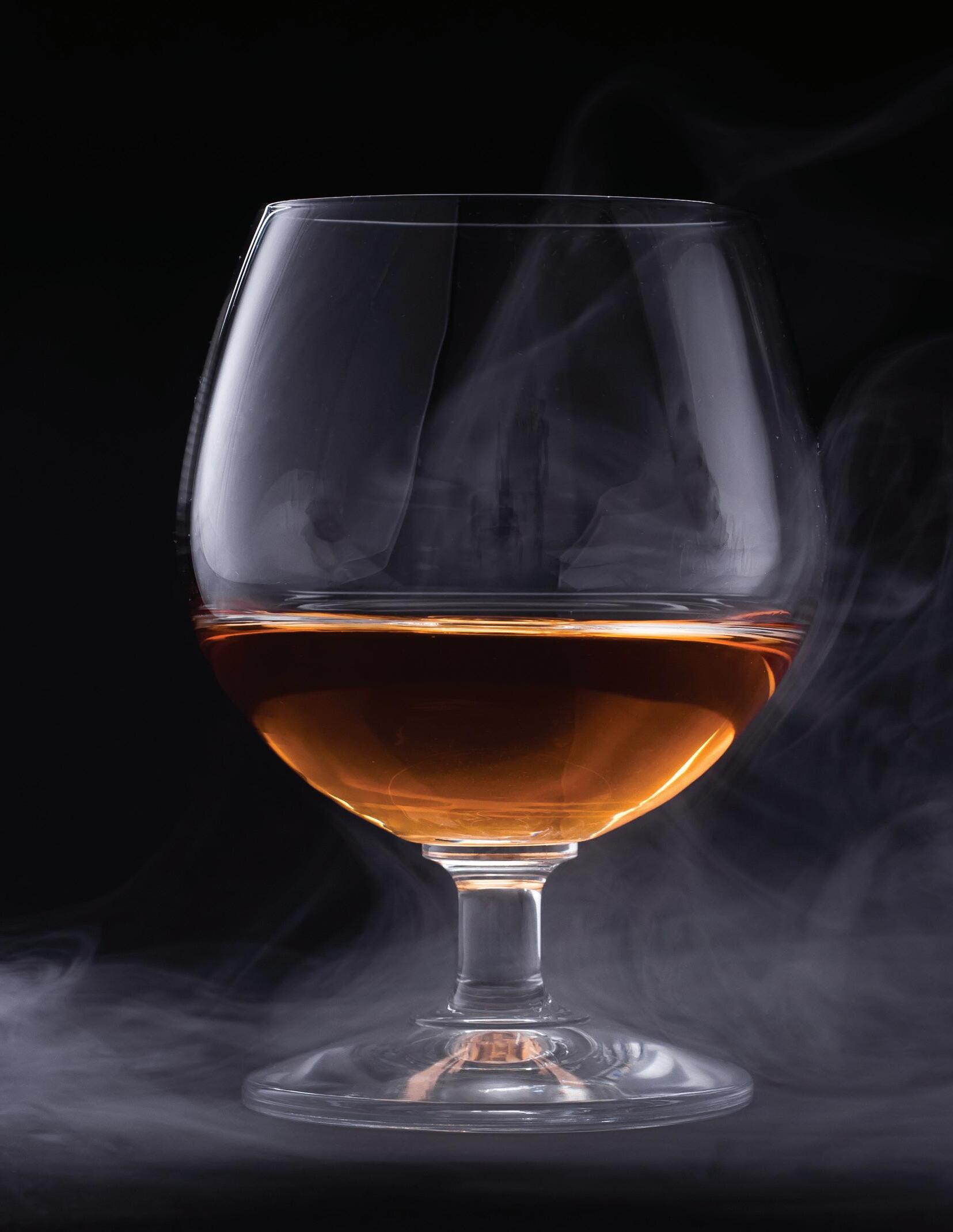
m y name is Philip i li Barake, s ommelier by trade. As a result of working with selected restaurants and wine producers in Chile, i started developing a passion for distilled spirits and cigars. As part of my most recent job, i had the opportunity to visit many Central American countries, as well as, rum distilleries and tobacco growers.
But my passion for spirits and cigars did not end there; in 2010 i had the honor of representing Chile at the i nternational Cigar s ommelier Competition, where i won first place, becoming the first s outh American to ever achieve that feat.

n ow i face the challenge of impressing the readers of “ g ot r um?” with what is perhaps the toughest task for a s ommelier: discussing pairings while being well aware that there are as many individual preferences as there are rums and cigars in the world.

i believe a pairing is an experience that should not be limited to only two products;
it
i

2023
As the end of each month approaches, among the myriad of things that i must do, one of the most important ones is the pairing for the magazine. s ometimes i start planning it weeks ahead, other times the pairing relies on my ability to obtain a specific rum via a friend or a client. i n some instances, however, the end of the month arrives and i still don’t have a plan. u nfortunately, this is the case right now. i had a couple of rums in mind, but nothing very clear and, of course, the actual rum selection dictates the type of cocktail i would prepare with it. Finally i opted for the Bristol Classic r um Port m orant, a 1999 d emerara r um, bottled in the u K in 2014. This Port m orant has a special aromatic character, with a medium-high complexity and high-ester alcohol, very reminiscent of pot still rum. The finish is elegant with well-incorporated notes of caramel and toffee, extracted from the w hite American oak barrels. i deally you’d consume this rum on the rocks or maybe with a splash of water.
Taking into account my rum selection, it was very clear to me that one of the cocktail options would be a personal favorite: the r um o ld Fashioned. i t is a simple cocktail that highlights and balances the rum’s character with sweetness. But i must clarify something first: this cocktail works best with unsweetened rums so, if you cannot find this exact rum, replace it with one that is exceedingly sweet.
The preparation is very simple:
• 3 oz. Port m orant d emerara r um
1999
• 1 oz. s imple s yrup (made with Brown s ugar)

• A dash of Angostura Bitters
• o range Peel for garnish
The preparation is directly in the r ocks glass, starting with the syrup, then the rum and ending with the bitters. o therwise, if you want to refresh the rum, add the ingredients to a mixing
is something that can be incorporated into our lives.
hope to help our readers discover and appreciate the pleasure of trying new things (or experiencing known things in new ways).
Philip # gr CigarPairing

glass with ice, stir it around a few times and strain into the r ocks glass with the orange garnish. i n both cases, finish the cocktail by adding large ice cubes.
For the cigar, i selected one from CA o Cigars, from the s ession line, it is 6 x 49 r ing, with tobacco from the d ominican r epublic and n icaragua inside and a Connecticut Broadleaf wrapper, grown in full sun in the r iver valley. i n this case, the wrapper is m aduro, very dark and attractive. As i was cutting the pigtail, which i had previously wetted in my mouth, i perceived a sweet sensation on my lips, something a bit unnatural but not at all unpleasant, even less so when i imagined the pairing with a cocktail having a similar taste profile.
w ith the cigar in one hand and the r um o ld Fashioned in the other, i could not avoid noticing the dominant toffee and caramel notes in the cocktail, while the first third of the cigar was smooth and silky, letting the sweetness take center stage.
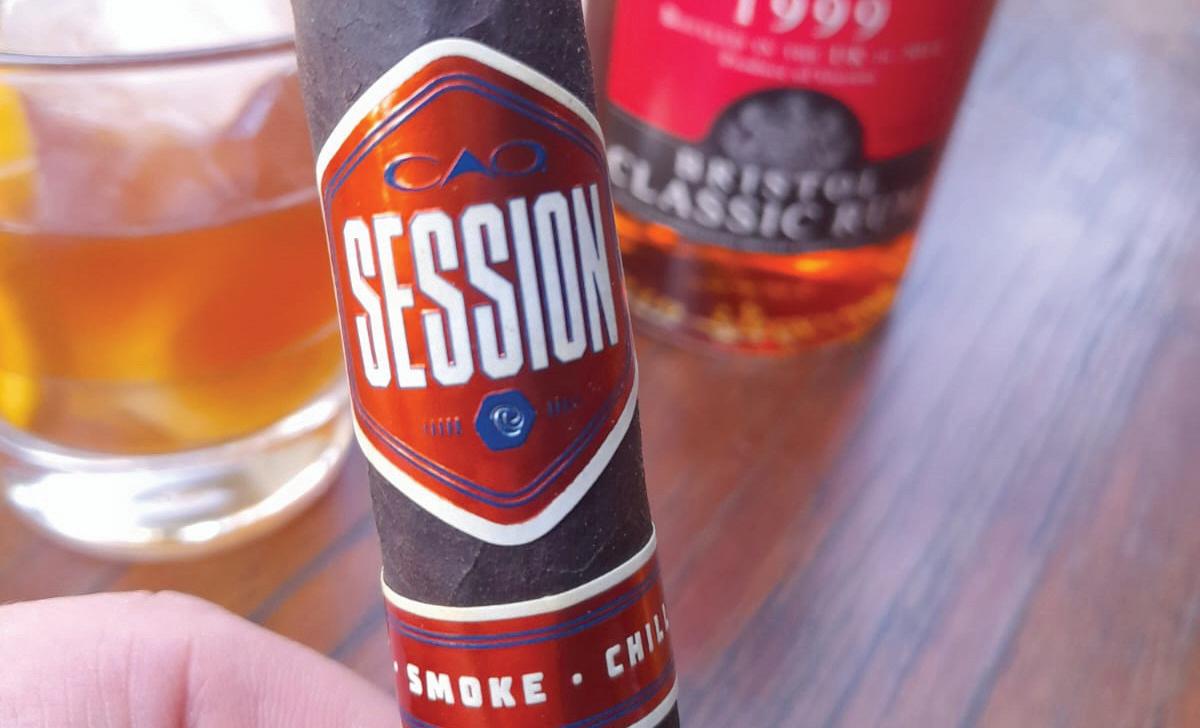
The cigar is very true to its composition, the intensity doesn’t go above the medium level and the sweetness of the wrapper, although still present, starts to slowly diminish during
the second third. The r um o ld Fashioned, meanwhile, has a more marked decrease in sweetness, but the alcohol character remains, so it is important for you to replace with a similar one, if you don’t have the exact one, a pot still or higher than normal congener level will be ideal.
This cigar may come across as intimidating to some, due to its dark color, given the impression of a full body (high intensity), but the truth is that it goes very well with aggressive rums, as well as, rums with a natural sweetness from being aged in fortified wine casks.
As i mentioned earlier, you don’t have to use the same ingredients, you can replace any of them, as long as you use products with similar profiles, paying special attention to the sweetness, duration of the rum’s finish in the palate, etc.
i hope that you can reproduce this pairing too and that you can personalize it to your liking.
Cheers!
Philip i li Barake # gr CigarPairing





